
www.bakingbiscuit.com 04 23 iba ’23 special Exhibitor highlights, Organizer’s guide Bread lines Bread is best! In the spotlight Women in leadership roles: Cindy Yao
Verhoeven Bakery Equipment Family has a long and successful history of tailor-made development, engineering and production for the food industry. In the bakery market the family labels have established a strong position due our innovation and creative turnkey solutions. We sell high end production lines and state-of-the-art machines. Developed and made by a wonderful team of dedicated people. They make us proud. We would love to show you why.


HANDLING Conveying Robotizing Depanning END OF LINE Packaging solutions System integration CONDITIONING Cooling / Freezing Vacuum Cooling The Neth erlands - T +31(0)412 630 545 - info@verhoevenfamily.com MAKE UP Laminating Sheeting lines Universal lines Donut lines Pie lines
IT’S
IN
FAMILY we make to bake PRE-CONDITIONING Product conditioning Proofing VERHOEVEN BAKERY EQUIPMENT FAMILY WWW.VERHOEVENFAMILY.COM
ALL
THE
Innovation starts here
The Gulf Stream system is collapsing because of climate change. It’s on the verge of shutting down around 2050, but it could even happen as soon as two years from now, according to a new study. The warm ocean currents last ‘rebooted’ approximately 12,000 years ago, during the ice ages. This is the point of no return on the path to catastrophic climate change – for us. Admittedly, the scientific community does not entirely agree with Prof. Peter Ditlevsen’s timeline, the study’s author. Its publication might also have fallen into the background of developments in the recent hard news cycle, too. Several parts of Europe are engulfed in horrendous wildfires, to name just one example. In other news, governments are discussing proof of alien life, a loud narrative in the media recently.
Catalina Mihu, Editor-in-chief

Your commments or suggestions are always appreciated: e-mail: mihu@foodmultimedia.de
Arson aside, the wildfires in Greece, Italy, and Canada are – to no small degree – another symptom of climate change; moreover, planted fires are so devastatingly effective because of climate changes. We’ve had the hottest June in history and several temperature records were broken in July (the hottest month ever recorded, according to Copernicus Climate Change Service. And, even if the timeline predicted by Prof. Ditlevsen is questioned by the scientific community, the scenario remains unchanged, and we do not gain any meaningful ‘extra time’ with the generally agreed-on timeline, either.
Against this backdrop, the industry has internalized the urgency of putting a hard stop to current practices, disruptive as that may be, and is making strides to run the business in a sustainable way. The interest in more efficient production, with palpable energy savings and emission reductions, is translated into action. Changes are happening now and they are happening fast. It’s no wonder that the underlying theme for the exhibitors at iba this year is ‘sustainability’. The show will host all the new and improved solutions and ideas that will help in the ‘sustainability’ race. You can read about various companies’ latest innovations to be exhibited at iba in our preview, in the pages of this magazine.
The key to lasting change is to entirely rethink and ‘change the recipe’, as someone put it in a recent interview: from the actual product recipe, for more sustainable products (a sustainability score will be the new nutri-score), to the ‘recipe’ of how we’ve been doing things. With this mindset, innovation starts here and now. And it’s inspiring to see it unfold, every day.
We at baking+biscuit internationa l and brot+backwaren are proud to be a part of a resilient industry and witness it power through a plethora of challenges, as it has recently been doing. It is exciting to uncover new, innovative ways to address sustainability concerns. You can expect to always find them in our magazines in the hope that they can help inspire you, too.
Catalina Mihu
03 EDITORIAL
“YOU WIN THE HEARTS, YOU WIN THE WORLD”
Cindy Yao holds not one, but two leadership roles at one of the industry’s leading companies. She talks about combining her responsibilities as Chief Financial Officer and Executive Vice President at the Markel Food Group in an interview. ©

AUTHENTIC, AFFORDABLE LUXURY SELLS
David Wagstaff, the managing director of St Pierre Groupe, discusses how the cost-of-living crisis is impacting the industry. He also talks about emerging trends, new products and advice to stay one step ahead in FMCG.
IT’S NOT A SPRINT, IT’S A MARATHON!
Last time iba was staged in person, it provided a platform for EUR 2.1 billion in trade fair contracts. Five years later, anticipations run high for the industry’s first ‘official’ get-together in Europe since the pandemic.

A VERY SPECIAL ORDER
In the spring of 2023, Ölz der Meisterbäcker put its expanded production into operation. When it came to raw material handling, the Austrian plant baker relied on Zeppelin Systems for solutions.

BREAD IS BEST!
Bread consumption is once again on the rise, with the market expected to grow annually by 6.80% and reach a worldwide volume of 216.70 bn kg by 2028. The technology to support efficient, automated production of high-end, quality bread is here.


LES TARTES SONT MAGNIFIQUES
Some of the oldest patisserie creations are also an undisputed dessert staple: pies and tarts. As they are continuously evolving, various techniques can perfect product processing in industrial bakeries, preserving the artistry of the skilled patissier.

www.bakingbiscuit.com 04/2023 CONTENTS 04
HIGHLIGHTS 06
COVER STORIES
38
Markel Food Group
22
© GHM
32
©Koenig
16
© Zeppelin
© St Pierre Groupe
52
© Adobe Stock (#615666202)
IN THE SPOTLIGHT
06 Women in leadership roles: Interview with Cindy Yao, Markel Group CFO and Executive VP
BAKERIES
16 St Pierre Groupe: “Authentic, affordable luxury sells”
PRODUCTION
22 Bread lines: Bread is best!
50 VMI: How to scale up artisan bread production
52 Mecatherm: Les tartes sont magnifiques
54 Siemens: Digitization and financing - Fit for the crisis, well equipped for the future
PORTIONING, FORMING, DOSING
28 VEMAG: The product is the measure of things
32 Zeppelin: A very special order
IBA ’23 SPECIAL
38 Exhibitor highlights: It’s not a sprint, it’s a marathon!
46 Oganizer’s guide to iba: Preparations, logistics, recommendations
MARKETS
56 Prof. Dr. James Bruton: How German craft bakers survived the pandemic

REG ULARS
03 Editorial: “Innovation starts here”
62 Advertiser directory

■ With the right belt types for every processing step
■ With HACCP types that sustainably support your hygiene concept
■ With reliable service in uncompromising quality
Siegling – total belting solutions
RELIABLE AND HYGIENIC CONVEYING
Siegling GmbH www.forbo-siegling.com Welcome to our Hall/Booth B2/400 October 22 –26, 2023
Forbo
FOLLOW US ON LINKEDIN
CONTENTS Cover photo: © ADOBE STOCK (#594483076)
“You win the hearts, you win the world”
Cindy Yao holds not one, but two leadership roles at one of the industry’s leading companies. She talks about combining her responsibilities as Chief Financial Officer and Executive Vice President at the Markel Food Group, the importance of leading a team while being a team player, and creating a Leadership University to support next-generation trailblazers.

+ Catalina Mihu: You were recently recognized as the 2023 Large Company Virginia CFO Of The Year by Virginia Business magazine. Congratulations on the award! How would you outline the priorities in your responsibilities today, in your double role as Markel’s CFO and Executive VP?
Cindy Yao: First of all, people/team have always been my priority regardless of what role I have. You need to always be present for your team. I regularly am in contact with them. I work with our China team when it's my night and their morning. The time zone difference helps me juggle all priorities better. At the same time, financial reporting, and compliance especially as part of a public company, is always most important with a clear deadline. I meet with my finance team regularly to understand what is going on. For the first few years after joining the company, we put comprehensive policies and governance in place, and now all the teams can work on their day-to-day tasks together to make sure all the bases are covered.
Regarding my double role, they complement each other: the business role helps me to understand our business deeper and broader. It helps me to see what is important for our customers and our teammates. It provides me the ability to be a better strategic partner for the CEO, presidents, and other business leaders: What KPIs are more effective to drive what behavior and results? What are the customer voices? What reporting is meaningful for business users and for operations? Having a finance ‘hat’ also means that I can be more vigilant to make sure we comply with regulations and tax requirements. If we start doing business in a new country, or a new region, for example, I can collaborate with the team quickly and understand what risks and regulatory requirements we need to consider. So, my two roles help each other: the finance role helps me be a better businessperson and the business role helps me be a better operational CFO. It is more effective and efficient.
“The heart of Markel”
Mihu: What should leadership at this level entail, and what is the unique perspective that women bring to this role?
IN THE SPOTLIGHT – WOMEN IN LEADERSHIP 06
”Once you reach a certain level, you need to internalize this: you work for your team.”
Cindy Yao , Chief Financial Officer and Executive Vice President at the Markel Group © Markel Food Group
Yao: As a CFO and an EVP, it is about personal growth and the growth of the people I serve. It is about having empathy and being in their shoes. My teams do not work for me. I work for them. That is the essence of Markel Business System – Inverted organization structure. Once you reach a certain level, you need to internalize this: you work for your team. It is not a saying. It is your doing. What do women bring to the table in leadership roles? In my own experience of working full time, having two children, and going back to school for my Executive MBA, I would say time management skill is critical, as is empathy – the ability to observe and relate to other people’s feelings and emotions. You may be in your business suit, look all put together, while at the back of your mind, you might be juggling daycare or ailing parents. My experience has made me better able to be more observant, to be able to listen to other people’s problems and challenges and create an environment and culture where my teams care about each other’s wellbeing and work together more effectively.
Mihu: This is a question that is exclusively addressed to women: how do they juggle their personal life and their careers?
Yao: You have to be comfortable with the choices you make. Work/life balance is such an out-of-this-world goal. It’s very difficult to truly achieve a balance, but there are often tradeoffs. I remember the times when I missed my children’s milestones and school activities because I was either traveling or busy with meetings. But, at the same time, this has helped me be more mindful of my teammates’ time commitment for work and life. For example, if I know that there are people with children in their care, whether it is a father or a mother, I do my best to avoid scheduling meetings for early mornings. That is precious family time, when they feed the children and take them to school.
Mihu: How does the team perceive this perspective, of you working for them?
Yao: They respond well to it. With this mindset, we work together cohesively, and I have people reaching out and wanting to share their life stories and struggles. They use me as a sounding board. A heartfelt comment from a recent 360° survey stayed with me: it said I am the heart of Markel. While I was working at Bausch+Lomb, in the engagement survey of my department, teammates said my boss works for me. It’s great to see people recognize it when you put them first and work to help them. They want to work with you, enabling certain changes together or advancing in one direction. In Chinese, we say, “You win the hearts, you win the world” and this is how I operate. Care for your people first!
Mihu: What is at the heart of Markel?
Yao: The heart of Markel is a way of our doing and being. It is the peace coming from the fact that we care about each other, we respect one another, and we challenge each other for the better of our own growth and company
growth. Of course, we care about our results; but people come first. We ‘build’ our people before we build machines. That is our heart. Most recently I saw a quote: “Sight is a function of the eyes. Vision is a function of your heart.” It seemed to agree with me that it is all about the heart!
The Markel Business System
Mihu: Speaking of working with and for people, you also celebrate a significant milestone this year: 10 years with the Markel Food Group. What are some of the most significant moments for you throughout the past decade?
Yao: Several moments come to mind; for the first three years, we transformed our company from a more entrepreneur type of organization to a more professionally run organization. We set up the fundamentals and the control framework and governance process. Then, in 2017, we embarked on the journey to create and implement the Markel Business System, which combined tactical tools with a holistic continuous improvement mindset. The past three years, I took on more commercial/business responsibilities. Working with the business directly gave me more appreciation of our front-line managers and teammates. I would say the creation and success of Markel Business System Leadership University is the biggest milestone and recognition for me, my team and the company.
Markel Business System, Leadership University
+ Monthly requirements:
One 90-minute session per month
– Two separate 45-minute coaching sessions
Continuous skill application
+ The final session is held in person for one week, including graduation
+ Each student must successfully complete three Problem-Solving Projects (PSPs). They receive MBS PSP Champion certifications by December 2023
Mihu: You led the creation of the Markel Business System Leadership University. The first attendees of the MBS Leadership University graduated last year. How was it developed and how does support Markel Food Group teams and customers?
Yao: The concept of the university is to bring leaders and high potentials together, to share knowledge and support each other in understanding our customers, ourselves, and our industry. It aims to amplify the customer’s voice and teach a unified set of values and skills throughout the Markel Food Group. Those joining the Leadership University are selected and prepared to be able to lead themselves and others, as well as the business. It is designed to identify and train the successors for presidents, directors and other succession needs.
07 IN THE SPOTLIGHT – WOMEN IN LEADERSHIP www.bakingbiscuit.com 04/2023
–
–
Mihu: What does the syllabus look like?
Yao: We split the program into two categories. One hones on leadership skills and teaches how to be a genuine leader and work in a team setting. It includes team and selfassessments. The other module focuses on tactical tools that can be used to solve problems, including KAIZENs, risk assessments and VAVE. We work with the students to create a five-year personal development plan, to see how the company can provide opportunities for them achieving their career growth.
Mihu: What resources are available to students during the program and who are their trainers?
Yao: We had a certified trainer from our HR department run our first class. We also acquired specialty training materials. The MBS Director and I teach lean tools and concepts. This year, I became a certified trainer for leadership courses to coach and teach with help from an external HR consultant. Our graduates have also become coaches. The students have full access to all of us. It has been a privilege to teach and learn from my students. They call me the Dean, best title ever.
Mihu: What are your other responsibilities regarding the University?
Yao: I work with the MBS director and HR consultant in designing the curriculum. We seek frequent feedback from the students, presidents, regional leaders, and managers on how to improve our materials and course structure. We have individual coaching sessions with the students, where they share with me their career aspirations and their challenges. I also have scheduled sessions with students and their coaches (who are the graduates from last year), to make sure we maintain a cadence and that we move forward with all the problem solving. This is my way of engaging both the existing students and the graduates in implementing MBS. One example of a PSP the students must solve are along the lines of: ‘Why is my newly-built equipment module X% lower than we expected?’ The student and his coach work together to find root causes and counter measures to eliminate this gap. These case studies can be used by other sites within MFG to improve our financial results and motivate our people.
All in all, the role of the MBS Leadership University is not to issue a diploma but to create an army of problem solvers! It is about changing the culture, changing the mindset, and changing the way we do things. To put things into perspective, 31 students have enrolled in the program so far. They will be the leaders that will make a difference in the future.
Mihu: How is a problem-solving session structured?
Yao: The MBS definition of a problem takes away all the guesswork and subjectivity: ‘Do I have a standard/goal and where am I in relation to it?’ If there is a gap between the two and has a trend, then the gap is the problem! We need to close the gap and solve the problem. Once we have a problem statement, we will ask the five why’s to identify root causes and preto the data to focus on the 80%. Problem-solving is a continuously changing process, because, while we might find some causes for it at first, we might later refine the scope to make sure the potential solutions are possible. We call this process PDCA: you plan, you do, you check, you act. This is how we move forward.
PDCA
PDCA or plan–do–check–act is an iterative design and management method used in business for the control and continual improvement of processes and products.
Mihu: Who can join this program and how are the students selected?
Yao: Presidents, and regional leaders and leadership teams recommend candidates. We do have a class size limitation because we want to have extensive one-on-one time. We ask for candidates from all our companies – AMF, Reading Bakery Systems and Solbern. The only branch that hasn't been able to have students join the program yet is our China operation because of pandemic traveling restrictions. I expect that we will have someone take part next year.
Mihu: What is the role of the KAIZEN principles in the organization of the MBS Leadership University and in the day-to-day work at Markel Food Group?
Yao: KAIZEN stands for incremental improvement. It is a way of solving a problem or improving a process. A KAIZEN mindset means seeking continuous improvement, big and small. The most important thing about having a KAIZEN mindset is that you see the need for improvement.
At the MBSLU, we teach how to organize and facilitate a KAIZEN. It can be related to self-improvement or that of the team and the company.
Mihu: And why did you decide to embark on this project?
As I get feedback on our program throughout the year, we keep improving our material and planning for the next class.
Yao: I have always been extremely fortunate regarding learning and training. I believe knowledge does not simply appear. You must actively seek it and you also need
www.bakingbiscuit.com 04/2023 IN THE SPOTLIGHT – WOMEN IN LEADERSHIP 08
”KAIZEN stands for improvement. It’s a way of solving a problem or improving a process. A KAIZEN mindset means seeking continuous improvement, big and small.”
Cindy Yao , Chief Financial Officer and Executive Vice President at the Markel Group
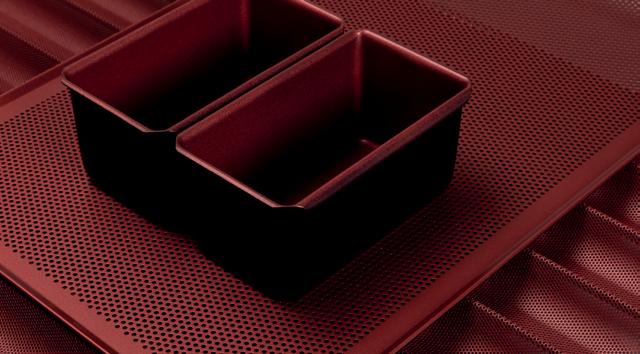


3 reasons you should visit us. Kempf GmbH | Carl-Benz-Str. 3 | 85296 Rohrbach | Germany | +49 8442 9669 0 | www.kempfgmbh.de Visit us: A1.365 new products waiting for you low energy trays for saving money PFAS free coatings new developments & solutions bakeware and coating bakeware and coating
coaches and mentors to help you on this journey of learning and acquiring knowledge. Education is one of the best ways to obtain knowledge and change our mindset. MFG grew partially through several acquisitions. What are our shared values and ways of leading our teammates and serving our customers? Do we speak the same business language and apply the same operating principles? What binds us together is our business system. I knew we needed an institution to educate and train our people to adopt, implement and experiment our MBS. Therefore, we embarked on this education program.
We borrowed the idea of having a MBSLU through the experience I had at Bausch + Lomb, which had a university, although with a different focus. In the long run, our goal for the University is for it to run with alumni to build a network of problem solvers and KAIZEN practitioners. MBS is becoming the language of our business, a skill we keep perfecting. Personally, I also insist that more women students join the program and the company and receive training that will prepare them for future growth.
10 years with Markel
Mihu: How have values and strategies at Markel adapted and evolved over the past decade?
Yao: At the root, the values and strategies remain the same: customer satisfaction and teammates engagement are our pursuit. Through acquisition and innovation, we are able to provide broader offerings and serve more customers in different segments and different regions. The execution of the strategy evolved as we expand and with our implementation of MBS. Individually, each of our companies still needs to advance in its market segment; but collectively,
we are a much bigger and stronger company: we have presences and reach in many countries. We have groups of experts in baking and food processing technologies. We benchmark internally and externally. We leverage our innovation centers, manufacturing sites, currency advantages, geographically disbursed service techs. Our global footprint, wealth of knowledge and our multinational team enable us to win.
”As a company, we do have a high-level strategic deployment plan regarding automation and digital transformation. We will gradually introduce new solutions in the market that go beyond simply automating processes and use machine learning to continuously adjust these processes.”
Mihu: How did the pandemic bring everyone closer?
Yao: During the pandemic, we made an effort to stay connected and combat the ‘pandemic enemy’ together. I definitely increased my frequency of speaking with the leadership team at Reading Bakery Systems, Solbern and Markel TJ. It made me realize even more that we can’t take every interaction with our teammates for granted and make the best use of our time together. Through the Markel Business System Leadership University we also stay connected via MS teams solving problems. The University offers us a forum and a very collaborative and organized way to assess what lies ahead for us, as a group.

www.bakingbiscuit.com 04/2023 IN THE SPOTLIGHT – WOMEN IN LEADERSHIP 10
Cindy Yao , Chief Financial Officer and Executive Vice President at the Markel Group
© Markel Food Group
THE ONLY BAG CLOSURE THAT’S HOME COMPOSTABLE.


Mihu: How do the R&D teams from all the companies work together?

Yao: The speed of innovation is getting faster. To be the leader in the industry, we must invest in R&D. Being a CFO, I understand the short-term and long-term impact on our results. Our short-term profit needs to enable us to invest for the future. Overlooking the group companies R&D spending and direction enables me to find synergy and collaboration between the companies to make our R&D more effective.
president said to his team that “Cindy is part of us.” I totally enjoy working with Reading Bakery Systems, Solbern and MFG TJ in my EVP role. To feel part of the team and knowing you are a helper making things go right is the best feeling. The next one would be seeing the graduates getting promoted and taking more responsibilities with confidence.
Mihu: It’s inspiring to see that the focus is on people and their milestones – the people behind the innovation, rather than the innovation itself.
Yao: It’s always about the people! The right people with the right leadership make companies do great things.
Mihu: Speaking of KPIs , how would you summarize KPI priorities at Markel?
Mihu: What lean organization principles can a company with a global reach benefit from?
Yao: We are on the journey to become a lean organization. We have a lot of work to do. The pandemic exposed many of us to supply chain challenges. It helped us to focus more on our supply chain management. At the same time, to become a lean organization, our leadership must have a KAIZEN mindset. We must continuously seek ways to do better and share the knowledge of improvement across Markel Food Group.
Mihu: Speaking of success milestones, what are some of your favorite moments of the past 10 years?
Yao: In terms of favorite moments, I would single out earning trust. I remember at one of the business reviews, the
Yao: In my mind, the two biggest KPIs are safety and retention of good people. Safety shows, ‘We care about you’. No one should go to work and get hurt. Regarding people retention, we often say that people don’t leave their companies, but their managers. As managers, we need to ask ourselves ‘Do we have the right culture? Are we serving our customers well? Are we developing our people?’ Good scores in safety and retention indicates that we have done well in these three areas.
A global reach
Mihu: Looking at the global reach of the Group, How are the financial strategies of Markel Food Group’s main markets defined?
Yao: Our global reach enables us to shorten our lead time, reduce logistic costs and serve our customers faster in local languages. Our business and financial strategy of Markel Food Group has always been: 1. What’s best for the
www.bakingbiscuit.com 04/2023 IN THE SPOTLIGHT – WOMEN IN LEADERSHIP 12
”The future of the industry is ‘lights out’, highly-automated bakeries with minimum or no emissions. ”
©
Cindy Yao , Chief Financial Officer and Executive Vice President at the Markel Group
REDPIXEL –stock.adobe.com
Proven to Lower Energy Costs

ePAN® designs from American Pan have been proven to save bakeries money on every bake. In fact, one customer reduced gas usage by almost 8% year over year by switching to an ePAN.
Energy solutions like wind turbines and solar panels are a major investment and require a large amount of dedicated space. ePANs can fit on your existing bakery line and save you money from the very first bake. Here’s how:


DECREASED OVEN TEMPERATURE
Oven temperatures have decreased by up to 30°C when using ePANs.*
REDUCED BAKING TIME
Baking times have been reduced by up to 45 seconds.*
REDUCED WEIGHT OF BAKING TRAYS & TINS


Trays and tins are up to 30% lighter, requiring less energy from bakery systems and employees for handling.*
*Results from real bakery experience. Results may vary based on specific bakery conditions.
Jesper Albertsen | VICE PRESIDENT OF SALES +45 23 68 51 85 | jalbertsen@americanpan.com FIND US IN: Germany | Romania | Spain | Sweden | Turkey | UK | USA Visit us in Hall B1 - Stand 110!
customer? 2. What’s best for Markel Food Group? 3. What’s best for me (the company or region)? They are in this exact order.
Mihu: You led the restructuring and repositioning of several regional offices, including China and the Middle East. How were the group’s earnings in China doubled within 18 months?
Yao: The restructuring and repositioning of some of our regional offices are driven by tax and legal reasons. For China, I saw the day coming where TJ is not just a legal entity under AMF but a platform for AMF, the then Tromp Group, Reading Bakery Systems and Solbern for more customer reach and for more product offerings at more base models. In the past two years, we redefined our China strategy – win China and win the world. We saw the rise of Chinese competitors both in China and in emerging markets. However, our group technology, global reach, brand recognition and investment in our China operation give us an advantage. In addition, our TJ team is one of the best teams with most dedication. For example, during the pandemic, we had 26 people who slept in the factory to ensure on time delivery.
Mihu: How have recent disruptions affected Markel and what strategies emerged?
Yao: More recently, the chips supply has been an issue. As a result, we have a significant backlog. On the plus side, we could see where we can do better in response to situations such as this one.
Mihu: How would this problem be processed in the MBS Leadership program?
Yao: We must look at this problem objectively. We need to ask ourselves what are the things we can control, and what are the things out of our control? To be a lean company, we must emphasize more on what we can control, rather than just blaming the pandemic or the chip shortage. Seeing the need to improve is the KAIZEN mindset.
Imagining innovation
Mihu: One of the recent innovations developed by AMF Den Boer is the hydrogen oven. Was this solution developed in response to sustainability concerns from the industry, or does it reflect how Markel envisions the future of the industry?
Yao: The award-winning hydrogen oven is our response to sustainability concerns with our forward thinking. It is how we execute on our pledge of better food and better lives. We are making investments to lead the industry for sustainable oven technologies. When we first revealed the hydrogen oven, the market was interested but skeptical about the timing. In two years, we have seen the acceleration for adoption of green energy. When we first revealed the oven, the market thought we were 10 years too early. But now, in just two years, the market is saying that we arrived on time.
Mihu: Please highlight the group’s strategy toward investing in innovation – and the people developing it.
Yao: We redefined our innovation process within our organization. We have cross-company product development processed to share and leverage knowledge with dedicated R&D innovation centers. As we lead the effort in these breakthrough innovations such as Hydrogen/electric ovens and digital transformation, we are acquiring different talents and competence. This transformation is also for our leadership to change the mindset from a traditional mechanical engineering capability to AI embodied competence.
Mihu: We looked into the past 10 years at Markel Food Group. What would be key to continuous improvement for the next 10 years?
Yao: People are still the key. In the next 10 years, people/ talents will be retiring, including some of the presidents and other senior-level people. The University will be a good training ground for the next generation of leaders. At the same time, as technology changes, we need more talent in areas of AI transformation.
Mihu: Could more companies be joining the group?
Yao: Yes, depending on our strategy at the time, or on new segments we might want to focus on. But, that should be at the right time and with the right company so that we maintain the Markel Food Group culture and the Markel Style.
Mihu: And how should women’s representation be supported to grow in leading roles in the baking industry?
Yao: There are fewer women in the machinery industry, in general. As leaders, we need to promote people based on merit. You need to have the ability, the talent and the competence to do the job. With that said, we also need to make an effort to grow the presence of women teammates in leadership roles. Looking back at my life, I know that simply working hard is no guarantee for success. I have met managers who were willing to invest in me. Bausch + Lomb sponsored my E-MBA and put me through CXO training. Senior managers need to make a deliberate effort to grow the ranks of our women leaders and offer certain flexibility for their other roles such as motherhood. Creating an environment in which people can work better is the key. +++
www.bakingbiscuit.com 04/2023 IN THE SPOTLIGHT – WOMEN IN LEADERSHIP 14
”Senior managers need to make a deliberate effort to grow the ranks of our women leaders and offer certain flexibility for their other roles such as motherhood. Creating an environment in which people can work better is key.”
Cindy Yao , Chief Financial Officer and Executive Vice President at the Markel Group
F2M BOOK COLLECTION: the series
MULTI-LANGUAGE SPECIALTY BOOKS

AUTOMATION SCIENCE AND TECHNOLOGY

AUTOMATISIERUNG FORSCHUNG UND TECHNOLOGIE
Language: English (2021)
Hard copy: 180 pages
Price: EUR49,00*
Language: German (2022)
Hard copy: 204 pages
Price: EUR49,00*
*Including VAT, for the hard copy or e-copy. Shipping costs are not included.
Food2Multimedia GmbH Contact: Viktoria Usanova, usanova@foodmultimedia.de
YOURS NOW
ORDER
Authentic, affordable luxury sells
David Wagstaff, the managing director of St Pierre Groupe, discusses how the cost-of-living crisis is impacting the industry. He also talks about emerging trends, new products and advice to stay one step ahead in FMCG.
+Catalina Mihu: St Pierre entered a distribution agreement with ASDA in 2022, for three brioche ranges. Why were the Brioche Burger Buns, Seeded Brioche Burger Buns and Brioche Hot Dog Rolls selected to be sold at ASDA supermarkets?

David Wagstaff: The past few years have driven real shifts in consumer behavior and increased desire for premium, restaurant-quality products that can elevate at-home dishes. As such, ASDA and other major multiple grocers increasingly recognize the need to engage shoppers – and drive revenue – by ensuring their bakery department offers something ‘magnifique’. These are currently three of our biggest ranges and are enjoying growing distribution and sales in both grocery and convenience, with sales up by more than 100% compared with last year’s values and a 48% share of the brioche market, outpacing the growth of the category, which is up by 34% 1
In the last six months, the brand has secured increased distribution on its core and morning goods ranges with Tesco, Sainsbury’s, ASDA and Morrisons.
The first half of this year has proven busy for the brand in UK retail, as we steadily introduced innovative merchandising solutions, successful in the US, where St Pierre is the leading brioche brand, to UK supermarkets.
In January 2023, ASDA installed branded bays into 100 of its superstore formats, adding listings for St Pierre’s Mini Brioche Buns, Brioche Bagels, Brioche Baguettes, Brioche Loaf and Vanilla Brioche Tear & Share.
Then, in Q2 this year Morrisons followed suit, adopting new display solutions with our Eiffel Tower racks. St Pierre’s striking
Eiffel Tower displays are now driving footfall to the bakery aisle of 300 stores across the UK, with plans for further stores to introduce them in the coming weeks. After six weeks of testing, early results demonstrate that stores with the Eiffel Tower racks have seen a volume uplift of 31% 2
The branded bays and Eiffel Towers have already created significant uplift in sales for the brand but are also helping drive footfall to the category – assisting retailers in increasing basket spend. Shopper data from Tesco and ASDA shows that we are over-indexing with higher-value shoppers and we know that we are delivering category growth for our retail customers.
St Pierre is all about the experience – we prioritize the quality of our authentic products in order to deliver a brilliant experience with the brand. That experience starts in store and, through the consistent quality of our products, continues at home.
Mihu: Which consumers are you targeting with each of the three brioche ranges?
Wagstaff: St Pierre is all about affordable luxury. Our target consumer base is broad thanks to a diverse product range
www.bakingbiscuit.com 04/2023 BAKERIES 16
”St Pierre is all about the experience – we prioritize the quality of our authentic products in order to deliver a brilliant experience with the brand.”
David Wagstaff, Managing Director, St Pierre Groupe
© St Pierre Groupe
1Source: Nielsen Grocery Mults L52 Weeks to March 11, 2023; 2Morrisons Retailer Platform, April 2023
David Wagstaff is the managing director of St Pierre Groupe. He previously held high-profile commercial and management roles with some of the world’s biggest food brands. He had been running the US operation of St Pierre Groupe for two years before taking on the role of managing director in December 2022. The St Pierre Groupe portfolio includes the St Pierre, Baker Street and Paul Hollywood ready-to-bake brands and is headquartered in Manchester. The company also has offices in Ohio, US. The business joined the Grupo Bimbo family in October 2022.
that caters to all meal occasions. This versatility attracts everyone, from family shoppers to young professionals and empty nesters. We have seen, though, that we are bringing higher-value shoppers to the fixture for UK retailers.
St Pierre’s Brioche Bun and Hot Dog Roll sales continue to increase – and that growth isn’t just driven by people eating burgers. We know that consumers are enjoying our products for breakfast, lunch and dinner, because we are offering an affordable luxury. Despite recent challenges, consumers are still opting for quality products from trusted brands like St Pierre, to treat themselves at home. What happens when consumers ‘feel the pinch’, is not that they spend less money necessarily, but that they become more discerning with where and how they spend that money. That means that brands and suppliers offering quality goods have an opportunity.
The financial difference for consumers between buying ‘good’ or ‘best’ is marginal – therefore, shoppers are more likely to opt for the better quality, or premium offering in a low-value category. It’s different if you’re talking about cars or high-value purchases, but everyday grocery brands are subject to a different purchase journey – and knowledgeable brands – and retailers – should be ready to highlight quality goods to shoppers.
This also creates an opportunity for St Pierre specifically. Because we win out in independent hall tests on taste, texture and flavor, along with the versatility of our core items, we understand that driving trial is key. Whilst inflation might create a more risk averse consumer, perceived quality and multi usage is so important. Inflation is being felt across the board, in every sector. There will be two camps of shoppers, those who spend a little extra knowing they’re getting a better-quality product and become brand loyal; and those who don’t spend the extra, but consequently don’t have an experience that keeps them coming back. With St Pierre, retailers – and their customers – can make sure they have that positive experience every time.
Mihu: St Pierre products are now present in all of the UK’s top supermarkets. What is the distribution strategy for each of the chains (Tesco, Sainsbury’s, Morrisons and ASDA)?
Wagstaff: We are experiencing phenomenal growth in the top UK supermarkets, and that has stemmed from our core range of grilling season products – they were the first to be listed in the big four multiples. Our focus now is on driving the depth of distribution, making sure we are present across the full estate of the big four, and on broadening the range available through each of the major multiples. Our breakfast goods and recent listings there are a great example of how we are doing that. And as we’ve done that, we’re able to drive brand presence too, with the major UK supermarkets now trialing branded bays and our innovative Eiffel Tower displays.

Just in: St Pierre Brioche Bagels
Mihu: What are some of the most requested ranges and what new offerings have been introduced?
Wagstaff: One major new offering we recently introduced was St Pierre Brioche Bagels. These were launched in America first and were a product of many years of development. Bagels are an American staple and elevating and bringing some French flair to an American classic is a formula that has worked well for us so far, to make St Pierre the leading brioche brand in America. Equally, in the UK, breakfast is a booming market, with Brits eating an extra half a billion breakfasts in recent years 3 and consumption of breakfast staples like eggs and bacon on the up. 4 The appeal of a bagel is two-fold though; increasingly part of the UK bakery repertoire, bagels are on the rise and used more and more for lunchtime occasions too. We can help to further drive that growth through innovation and by offering a different experience, again tapping into multiple meal occasions. We have a unique proposition with our soft brioche bagel, that offers something different while combining two growing markets.
At St Pierre Groupe, any new product development is born of research and insight that demonstrates our products will
17 BAKERIES www.bakingbiscuit.com 04/2023
3Kantar, 52 w/e 17 May 2021; 4Waitrose
Drink
2021 – 22
© St Pierre Groupe
Food &
Report
(October 2021)
meet consumer demand. In the US, we have a pipeline of new products to introduce over the next few months. Often, we see US trends cross the pond to the UK. If that happens, we’ll be in a strong position to meet consumer demand here with a product range that is ahead of the curve. That was certainly the case with our Brioche Bagels. We have launched a number of other new products in the UK over the past 12 months, including a new vegan range of morning goods under the St Pierre brand, and so now, rather than focusing on new products, we are looking at pack sizes and how best to cater to changing consumer habits.
Mihu: The burger bun and hot dog category reached GBP 38 million (180% growth) in the last two years. How was this growth achieved?
Wagstaff: St Pierre is driving category growth by 39% by bringing higher-value shoppers into the store and encouraging premiumization in the bakery category. Our growth is down to our stellar team who continue to listen to consumer feedback, share insight with our partners and then deliver products to meet needs.

Grupo Bimbo acquisition
Mihu: What are the biggest changes since Grupo Bimbo acquired St Pierre Groupe? And what remains unchanged?
Wagstaff: Grupo Bimbo’s acquisition of St Pierre Groupe presents us with a fantastic opportunity to further our brands, globally. As part of the world’s biggest bakery business, we now have access to incredible resources and insight. The opportunity, particularly in America, is still phenomenal. We are steadily increasing distribution, but the market is huge, and so the potential for growth is unmatched. Our entrepreneurial spirit and our drive remains unchanged, and we continue to operate as an independent business, but with the impressive backing of Grupo Bimbo. It’s a very exciting time for St Pierre and our business.
Mihu: In light of the recent takeover, what are some of St Pierre’s priorities for 2023 and beyond? How do they vary on your main markets?
Wagstaff: We continue to operate as St Pierre Groupe, so our strategy and approach remain as they were. Our focus is on both grasping the opportunity in America and developing our business with our customers in the UK. As part of Grupo Bimbo, our exploration of new markets may accelerate, but the focus remains the same. We continue to push in the markets in which we already lead and maximize brand presence.
Mihu: What was the impact of the disruptions caused by the COVID-19 pandemic and by Brexit?
Wagstaff: The past few years have been challenging for the industry across the board. Rising costs of ingredients, production and freight, matched by labor shortages have meant bakery businesses have faced strong headwinds.
However, St Pierre has continued to face these challenges head-on, grow and assign resources to prepare for future trials. Throughout the last 12 months, we have invested heavily in our US and UK supply chain to ensure we continue to serve our customers at the impeccable level for which we are known.
The other challenge the industry needs to address is the cost-of-living crisis. We are seeing the impact of inflation in both the UK and the US – and while it means that for many, purse strings will be tightened as costs continue to rise, there is an opportunity for brands like ours.
Now is a great time for retailers to lean into premium brands like St Pierre – with the understanding of what ‘premium’ means for shoppers – beyond price point. For consumers, the trend for premiumization is here to stay. During the pandemic, shoppers were elevating their meals at home because they couldn’t travel or dine out. Now that the cost of living is on the up, consumers are still looking to treat themselves at home. Preparing and consuming better-quality foods along with entertaining guests at home is once again becoming more convenient and cost-effective than dining out. Elevated meals and quality products like St Pierre brioche, which save shoppers time and provide an easy solution for quality entertaining at home, are doing well throughout the store.
Mihu: How is sustainability addressed and communicated at St Pierre?
Wagstaff: We face two sustainability challenges at St Pierre Groupe: food waste and plastic-based packaging. Food waste is a huge challenge, and it’s increasingly being addressed both by the industry and by consumers at home,
www.bakingbiscuit.com 04/2023 BAKERIES 18
© St Pierre Groupe

who are more aware than ever before of the impact food waste has on climate change. Bakery goods are more likely than any other household food item to be thrown away.
St Pierre Groupe believes in making bakery magnifique –and as part of that mission, we are ensuring that our products do not go to waste.
That’s why all of our products benefit from extended life, helping to reduce waste from the moment they are produced. Beyond that, the business is committed to donating products regularly to food banks via charity partners, to ensure that our products are never wasted. We work with a number of charities, both in the UK and the US, and our partnerships are mostly organic, driven either by our team, or because they have a direct link to our business. We review our charity partnerships regularly, to ensure their objectives align with our own, either on an international, national, or regional basis. Any product not suitable not suitable for charitable donations is donated for animal feed wherever possible.
The other challenge we face is plastic-based packaging. Part of what allows St Pierre Groupe products to maintain shelf life and reduce food waste is the plastic packaging in which they are sold. Of course, as a business, we recognize that there is work to be done in reducing reliance on plastic packaging. Moreover, we are committed to exploring greener alternatives where such solutions do not compromise product quality.
As a result, we are committed to an annual review of all our packaging, in order to reduce our impact. In 2021, we removed unnecessary plastic from two of our core ranges saving almost 4 tonnes of plastic. The annual review from 2022 has been carried out and, as part of our commitment to action and transparency, the results are published on our corporate site. We know that our shoppers care that we are taking steps to counteract our impact on the planet and what’s important to consumers is of primary importance to our business.
New product development: trend spotting and social listening
Mihu: How are the special occasion recipes developed?
Wagstaff: At St Pierre Groupe, our recipe development starts with a mixture of trend spotting and social listening, allowing us the opportunity to put our products into multiple meal occasions. We look at the ‘demand moments’ rather than the product – what are people looking for, and then how do our products satisfy the need? We invest a huge amount in research and insight so that we can be helpful to our customers, and we take notes on what the competition is doing. The sector is dynamic and we are leading the way, trying new things, and working in partnership with our customers to get the best results.
”St Pierre’s Brioche Bun and Hot Dog Roll sales continue to increase – and that growth isn’t just driven by people eating burgers. We know that consumers are enjoying our products for breakfast, lunch and dinner, because we are offering an affordable luxury.”
 David
Director,
David
Director,
Mihu: What new territories could hold potential for further market expansion?
Wagstaff: As I previously mentioned, the opportunity for St Pierre in America is still phenomenal – we are increasing our depth of distribution, but the market is huge, and so the potential for growth is unmatched. Our focus remains on maximizing opportunity in our existing markets for the time being. As part of Grupo Bimbo, our exploration of new markets may accelerate and with Grupo Bimbo’s backing, we’re in a strong position to fulfill new market demands. We have ambitious growth targets and an entrepreneurial approach to meeting them, so it’s an exciting time for the business.
Mihu: What are the main differences between doing business in European markets vs. the US, from St Pierre’s perspective?
Wagstaff: American consumers are used to a sweeter flavor profile in baked goods, but European consumers have greater knowledge of what brioche is. Delivering bakery staples like burger buns and hot dog rolls has helped with the US education piece around brioche, how it differs and how to use it. It’s a little easier in the European market, because shoppers are more likely to understand brioche, but it is perhaps a ‘bigger leap’ to switch to a sweeter flavour profile than it is for American shoppers. So long as our commitment to quality is consistent, we will continue to make bakery ‘magnifique’, wherever we supply our products. +++
www.bakingbiscuit.com 04/2023 BAKERIES 20
Wagstaff, Managing
Sr Pierre Groupe
© St Pierre Groupe
PROGRESSA bread
Highest precision on the smallest footprint.











Our brand-new expert for tasteable quality.
 Ben Baker
Ben Baker
Bread is best!
Bread consumption is once again on the rise, with the market expected to grow annually by 6.80% 1 and reach a worldwide volume of 216.70 bn kg by 2028 2 . The technology to support efficient, automated production of high-end, quality bread is here. The key is gentle dough handling.
+Per capita, bread consumption should be over 24 kg this year, and it is poised for steady growth. Among the categories that entice consumers, artisan-style breads, premium ranges and perennial favorites such as baguettes are popular choices.
Royal KAAK: Baking freestanding bread
The Dutch ‘silo to truck’ solutions manufacturer develops production lines for all kinds of freestanding bread, with a capacity of around 7,500 kg/h, depending on the production process, type of end products and available space. Recently, lines with production volumes ranging from 2,500 to 5,000 kg/h have been frequently requested.
Rolls and boules can be made, from 80 g to 1,000 g, as well as crystal buns with an open structure. Molded products such as (demi-) baguettes and loaves can also be produced with this line, as well as pointed baguettes. When a sheeting line is utilized, ‘die-cut’ products are also an option, with several shapes (e.g.: triangle cut, angled cut, omega cut, hexagonal cut, or octagon cut). The line is not just limited to bread: it can also be used to manufacture pinsa, which, in some cases, should be proofed on peelboards.
The line replicates all the traditional process steps of when the dough was kneaded by hand, proofed in baskets and
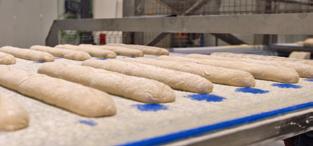

baked in a stone oven. Delicate operations when forming and handling the dough are key.
KAAK offers bulk fermentation solutions for this line, which support the quality of the end products and help reduce the additives needed.
”A focus point while using peelboards is the correct use of the release agents and flour on peelboards in combination with the type of dough processed. We always carry out internal project tests to optimize it.”
Dough processing and the end products are the central points of a freestanding bread production line designed by KAAK, explains Rens van Heesch, Product Sales Manager, DrieM sheeting lines. This means that the utmost care is given to the gentle handling of the dough, during the volumetric dividing process, or as it goes through dough sheet reduction. Either dough makeup systems can be used (lining up a divider, rounder, proofer and molder), or a sheeting line that is designed especially for bread processing. The standard line configuration features a sheeting line that is suitable to handle highly-hydrated doughs with long fermentation times. The operating principle is that the dough is gently reduced with the help of two multi-rollers.
Bread on peelboards and directly on belts
Highly hydrated doughs are placed on peelboards for processing. Once the dough is deposited on the peelboards, the dough pieces are placed in the KAAK final proofer. After decoration, they are ready for the oven, where a machine ‘peels’ the products from the peelboards and places them on the oven belt. The line cleans the
www.bakingbiscuit.com 04/2023 BREAD LINES 22
Royal KAAK specialists
© Koenig
1CAGR 2023-2028. Source: Statista; 2Source: Statista
© Royal Kaak
peelboard again and transports it to the start where new dough pieces are prepared for production.
“A focus point while using peelboards is the correct use of the release agents and flour on peelboards in combination with the type of dough processed. We always carry out internal project tests to optimize it,” KAAK highlights.

Even after the dough make-up phase, gentle handling is the main priority for the next process steps; for example, the pieces are carefully removed from peelboards and placed on the oven belt.
For dough dividing, the Dough Master was the equipment selected to be a part of this line. Nigel Morris, global head of technology at KAAK explains why: “This divider guarantees better control of the dough because it is completely servo-driven.” The company recently delivered two freestanding bread lines for rounded and oval molded loaves equipped with this divider.
Many other options are possible to meet the individual needs of the customer, for example top and bottom decoration of the dough piece as well as decoration by guillotine stamping.
New features
KAAK has recently brought new features to the freestanding bread line, making it more flexible and hygienic. “We introduced several new innovations: the robot scoring system is vision-based, which ensures a high degree of accuracy and flexibility in scoring patterns. It is perfectly suitable for multi-product, freestanding bread lines,” KAAK highlights. Different types of cutting tools can be used, depending on the type of dough being processed and the desired cutting pattern.
The rounding unit of the DrieM sheeting line has also been recently upgraded and can now handle 5,350 pieces of dough of up to 850 g. In addition, the soft dough sheeting section has been revised and now provides better access for cleaning, to meet increasing hygiene requirements from the industry and based on the specialists’ field experience.
Process consistency
The line closely controls the process to maintain it under the optimum parameters. For example, standard solutions integrate check weighing into the dough make-up lines. The mixing process is monitored, with temperature sensors that can be placed in several hoppers. This ensures mixing consistency at all times. All temperature and, in some cases, humidity settings for proofing, baking, cooling and freezing are checked and automatically adjusted. The PLC data can be connected with existing MES systems, to share information related to production to the overall data management
system. “On request, we also offer the possibility of integrating constant monitoring of the motor amperages,” KAAK specialists explain.
In addition, detection points have been integrated into the sheeting line to automatically control the process. As a result, fewer interventions will be needed from the single operator, required to run the line.
Flexibility: FRITSCH IMPRESSA bread line
FRITSCH will showcase a completely new design of its IMPRESSA bread line at iba this year. The new improvements focused on its hygienic design, as well as making it more compact and more flexible. The IMPRESSA bread can run as much as 9 tons of dough per hour, depending on the product, with various resting times – as long as 24 hours.
”The
centerpieces of our SoftProcessing
technology are the dough sheeter SDS and the satellite head.”
FRITSCH specialists
“With a special sheeting technology (which also includes an improved dough sheeter for soft doughs), not only do we save a lot of space, but we also produce a uniform dough sheet and reduce scrap dough,” FRITSCH highlights. All the components of the line are designed with the new hygienic design; they offer improved accessibility, are easy to clean and are washdown capable. There are different options available to ensure high flexibility when manufacturing a wide range of products. The line’s modular design means it is always configured according to the needs of the individual operation. Various features can be integrated into existing lines, such as decoration units, for example.
23 BREAD LINES www.bakingbiscuit.com 04/2023
© Royal Kaak
For process consistency, FRITSCH equipped the IMPRESSA bread (and all its industrial lines) with a new, output-based line control. How does it work? The operator simply has to enter the number of products he wants to produce per hour and the line calculates all the necessary parameters to achieve this result. “The software even checks whether the desired performance change is feasible quality and reproducible results,” the specialists explain.
Soft processing technology
The modular design of the IMPRESSA bread supports the manufacturing of a wide range of products, either cut, roundmolded, or long-molded shapes. Rye dough or special doughs, for example for Pinsa, can easily be processed. Moreover, strewn products or special decorations are also possible, utilizing the product decoration unit.

The Dough Sheeter SDS on the IMPRESSA bread can process soft doughs with a long pre-proofing time, and it does so very gently and with a minimum amount of oil. FRITSCH explains the principle of the SoftProcessing Technology supporting the process: “The centerpieces of our SoftProcessing technology are the dough sheeter SDS and the satellite head. In the SDS, a sensor monitors the filling level above the two-star rollers. This ensures that there is always a constant level of dough above the star rollers and that no compression of the dough occurs. If dough is needed, it is automatically fed through the conveyor belt. The big advantage of the SDS is that it flours the dough sheet on all sides. For the outer sides of the dough sheet, we use a fold-up belt (FRITSCH patent) which is previously dusted with flour. Flouring the dough sheet on all sides means that there is no need for oil during further processing.”
The SDR then sheets the dough very gently. The satellite head technology produces a consistently uniform dough sheet. Even its edges are homogenous, as no shearing forces and separating agents are used. Stretching and compressing are avoided at transfer points with the use of knife edges.
In addition, drop heights are also either avoided entirely or reduced to a minimum. “This allows even soft and rye dough to be processed reliably,” FRITSCH explains. The use of non-contact dough loop control helps with stress-free dough processing, with the added benefit of high accuracy in shape and weight, over the entire width of the dough sheet. In this way, scrap dough is reduced to a minimum.
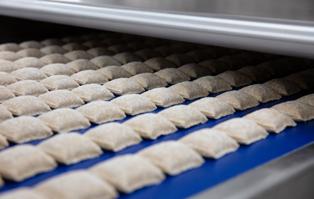
And process-control software
Process efficiency can be optimized by integrating the FRITSCH Smart Services. With the ‘Smart Production Insights’ (SPI) service, operators have access to live production updates and ensure complete process transparency. “Production managers or shift supervisors want to have an overview of the most important performance data of the equipment in as close to real-time as possible, even more so in the case of downtimes caused by minor malfunctions, or the maintenance status of the equipment.” FRITSCH explains.
The latest Smart Service FRITSCH developed is the so-called ‘Watchdog’ for the line drives, which constantly measures and analyzes their operating parameters. As soon as the deviation from the empirical value exceeds a certain limit, the production manager receives a warning to check the motor at the next maintenance and, if necessary, to replace it before it breaks down.
A flexible product portfolio
The IMPRESSA bread is most frequently used to manufacture round-molded products with long pre-fermentation times. Many lines are also equipped with a baguette unit for long-molded products. FRITSCH can offer several features that can be integrated into existing lines to further increase the product variety that can be made with them. “Our latest product innovation is for twisted bread rolls, which can now be produced fully automatically, in high volumes, with the new Dough Twisting Unit (DTU) on our IMPRESSA bread,” FRITSCH reveals.
www.bakingbiscuit.com 04/2023 BREAD LINES 24
© FRITSCH








With the Product Decoration Unit (PDU), decoration patterns can be printed or cut into the surface of products, for unique-looking products. The machine can make decorations by pressing or cutting shapes into the dough, not only on round-molded products but also on rectangular and longmolded ones. In addition to molded bread rolls, dough pieces can also be stamped/punched or cut out, then decorated with a pattern. Products of virtually any weight can be processed: a vision system ensures that the desired pattern is always applied exactly in the center of the product.
Automated premium bread lines: Koenig
‘Artisan’ and ‘premium’ are often used interchangeably when referring to bread. To Koenig, ‘premium’ products are crusty breads, with complex flavor and a chewy crumb. They are the result of long and slow fermentation and processes that cherish the tradition of handcrafted bread, made from scratch without preservatives or enhancers, but with high-quality ingredients, the specialist shares.
make-up as technology has advanced to allow the retention of dough cell structure and made it easy to process different kinds of dough and perform changeovers. Products were traditionally made by hand can now be automated, while still retaining their artisan character. “When using an elaborate processing line, bakeries can achieve higher weight accuracy, more gentle dough processing and absolutely even density of the dough sheet, when producing artisan bread doughs,” the company’s specialists stress. For example, a dough sheet forming system for various dough types can be incorporated into the line, or the TwinSat double satellite head for the gentle processing of the dough sheet.
Koenig can accommodate any product forming requirements: “We integrate guillotines for cutting breads in different sizes and shapes, including decorative patterns.” Forming stations can also be incorporated in these lines that flatten dough pieces, convoluting them. With subsequent seeding, breads can also be decorated. “We built a large bread line with a long intermediate belt. Along this belt, production staff twisted the bread dough pieces into the company’s typical shape. The customer wanted to have this ‘hand -crafted’ style, so we integrated it. After manual forming, it became a fully automated line again,” Koenig shares an example of a recent setup.
”In transferring artisan knowledge to industrial production, we always look for solutions that make the equipment easier to clean, easier to operate and minimize downtimes.”
For final proofing, the company recommends solutions such as step proofers, rack proofing chambers or tray proofers, ideally fully enclosed by thermo-insulated panels.
The Austrian technology specialist designed its automated bread lines with premium bread ranges in mind – which mostly encompass doughs with long fermentation times and very high water ratio, such as Mediterranean white bread with more than 80% water content, or rye breads containing up to 90% water. These premium bread lines cover all processes from mixing up, to dough processing, product handling, proofing, baking and through to cooling and freezing. Dough processing mostly determines production capacity, which can go as high as 5,000 kg of dough throughput per hour, on setups that use the Menes-H dough sheeting line. Small-pore and large-pore dough can run on this line. For processing and forming of bread doughs, Koenig recommends dough sheeting lines, such as its Menes, designed for this purpose.
Sheeting lines have become a popular solution for dough

For baking, the multi-deck tunnel oven MDI STRATOS with indirect heating is Koenig’s choice for this line, due to its ability to combine modularity, power and control in a compact design. The heat transfer to the product takes place mainly by radiation, but also by contact and natural convection, Koenig explains. The decks are completely independent, which allows the management of different production rates and/or different products to be baked simultaneously. “Each adjustment zone has a dedicated combustion, ventilation and heat exchange system, as well as a set of probes, allowing the independent control of temperature,” Koenig’s specialists explain.
When dealing with long fermentation times, which is often the case for premium breads, a final proofer can help to achieve consistent quality by ensuring constant conditions.
www.bakingbiscuit.com 04/2023 BREAD LINES 26
Koenig specialists
© Koenig
For cooling and freezing, custom spiral solutions from the newly-acquired Finish manufacturer Vulganus are added to the equipment lineup.
Custom-designed, automated processing
When working with bakers to customize a premium bread line, Koenig first aims to learn the artisan handcraft process and then transfer this knowledge to industrial production volumes, without any loss in quality. “This means creating dough processing principles for the most gentle dough handling with regards to the latest trends in bread consumption, e.g. processing bread doughs with long fermentation time, seeds, sprouted grains, etc.,” details the specialist, adding that, “In transferring artisan knowledge to industrial production, we always look for solutions that make the equipment easier to clean, easier to operate and minimize downtimes.”
Automating sensitive bread doughs does not mean the exact same procedure will be used every day. The competence to make small changes, also in automated production, is still a very necessary skill to have, in order to be able to react to a number of variations that may occur. Factors such as temperature, humidity, flour quality, etc. can have an impact on artisan bread production. “In our experience, we find that bakeries sometimes underestimate the effect of these surroundings or have problems with finding the right staff to react to these parameters in the operational business,” Koenig illustrates.
Consistent bread quality
The biggest challenge in processing artisan, premium breads is consistency – regarding dough quality and texture, dough processing, and bread quality, respectively. “Bakeries wanting to scale up their bread production with consistently high quality need to have one thing: a perfect process organization,” Koenig underlines. All the solutions lined up in the premium bread production contribute to increasing the quality of artisan products. By establishing a full process, it is easier to control the production, even if it is scaled up, Koenig points out.
The company shares advice on how to mix and process artisan bread doughs, for consistent results: “Doughs with extensive fermentation time need steady conditions, e.g. by placing the mixing bowls in evenly air-conditioned rooms or chambers. When mixing several batches for use on one processing line, the mixing times need to be coordinated with the floor resting times and the processing times. The floor resting time must be exactly the same for each bowl of dough. We recommend making the batches in a size that can be each processed in approximately 15 minutes on the dough processing line – preferably on a dough sheeting line for bread doughs. This has turned out to be a good referential number.”
Improving equipment features
For new technology developments, Koenig focuses on producing artisan and premium breads and buns with high weight accuracy. For this, scaling systems that are built into the dough sheeting lines play a key role, as they continuously coordinate cutting the dough sheet in the right place, to achieve the right weight.
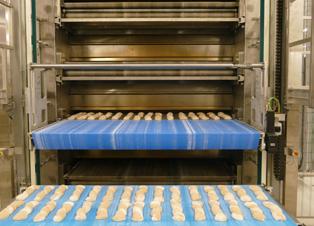
“We are also working on processing long-fermented doughs in large batches. Scaling up artisan doughs to an industrial level without quality loss was not possible until recent years but today’s technology enables it,” Koenig highlights.
Flexibility remains in high demand, too: “Customers ask for ‘all-in-one’ solutions - one line for all sorts of doughs. The key is to form a homogeneous dough sheet on one line for both soft and large pore doughs. Koenig overcomes this challenge both for the Menes-H line and Artisan SFM EC line with a sophisticated dough sheet forming system, which can be adjusted with rollers and sensors for individual doughs,” the specialists explain.
Koenig has been closely focusing on hygienic design for several years now, to ensure machines stay clear of flour, dust and waste dough, which can all cause machine wear and can even bring bread production to a stop. Allergens and staff safety are also addressed by new equipment features. To meet such industry demands, Koenig developed the wash-down ‘H’ hygienic design series and the ‘Easy clean’ series for easy cleaning and accessibility, which cut cleaning time at least in half, according to their customers, the specialists point out.
Solutions to support the growing preference for high-end, nutritious breads are here, for any production requirements. +++
27 BREAD LINES www.bakingbiscuit.com 04/2023
© Koenig
The product is the measure of things
Every gram counts. This is especially true when raw materials become more expensive or even scarce. VEMAG takes weight accuracy very seriously with its portioning technology. The machine manufacturer also sets the bar high in terms of product quality and flexibility.
By Helga Baumfalk
+With systems and machines that perform tasks such as portioning, forming and dosing, VEMAG Maschinenbau GmbH is represented in many sectors of food production. The spectrum ranges from butcheries and dairies, the production of snacks/protein bars, confectionery, or plant-based products to pet food and, of course, bakeries. “Passion for products – that describes us pretty aptly,” explains Managing Director Christoph Thelen. “By that, we don’t mean our products, but those of our customers. Orientation to the end product has always been important to us. In recent years, we’ve further expanded our focus on the respective industries and aligned our development accordingly with our own teams of specialists.”
Around 20 employees work at VEMAG for the bakery sector alone, including master bakers, bakery technicians and food technologists who are active in the BIC, the new Bakery Innovation Center (see box). Separate testing and competence centers have also been set up for other food and non-food sectors at the company’s headquarters in Verden, Germany. “Different industries have different requirements,” observes Alexander Bressler, Product Manager, Sales, Bakery. With test centers appropriately equipped to meet the respective requirements, it is possible to respond individually to customers’ needs, he adds. “Our goal is to communicate with all our customers at eye level,” says Thelen. This is why it isn’t unusual for many people in the company to have a ‘food background‘.
Since 2001, VEMAG has been a part of the US-based Robert Reiser & Co of Canton, MA. Reiser itself does not build any machines and gives its German subsidiary free rein in the management of the company. Both are in a kind


© VEMAG
“Despite the challenges posed by the war in Ukraine and the pandemic, we have managed to continue our overall growth. Here we benefit from our broad-based structure and proximity to international markets through our agencies.”
www.bakingbiscuit.com 04/2023 PORTIONING,
28
Christoph Thelen, Managing Director, VEMAG
FORMING, DOSING
of supplier-customer relationship with each other. VEMAG manufactures, Reiser sells the equipment – and that of other manufacturers – in the USA, Canada and the UK. Similarly, VEMAG works with other independent agencies and its own subsidiaries, e.g. in China, the Netherlands, or Poland, through which the machine builder is represented in more than 120 countries worldwide.
A functioning after-sales system is important, says Christoph
Thelen. No one can afford downtime, he adds. “When it comes to service, we don’t differentiate by industry, because the technology is similar.” In export markets, agency technicians are responsible for maintenance and service. All service personnel are trained at the VEMAG Academy in Verden.
More than 80% export share
At over 80%, the company’s export share is high. North America, the UK and European countries such as the Netherlands, France and Poland are among the main sales markets. The
The bakery all-rounder

It is one of the latest developments from VEMAG: the HP1 or better said, the bakery all-rounder. The dough portioner is designed for medium-sized artisan bakeries. It can convey thin or stiff masses even with pieces (according to the company, without losing volume or destroying pieces) and divide or dose doughs with a dough yield of 155 to 220 just as well. The machine operates in a weight range from 5 g to 50 kg. “One customer where it is already in use is using it to produce 25-gram cookies for food retailers,” Alexander Bressler tells us. “He could just as easily run his bread doughs over it.” The dough portioner can be combined with various attachments. One attachment can be used, for example, to fill sponge cake and stirring masses into molds or cake rings with weight accuracy. “The attachments give the baker product flexibility with one system,” Bressler said. The hand-filling head could be used to dress macarons, meringues and macaroons, or to fill masses into jars. As for the variety of shapes, that is almost infinite, he says.

company is also successful in the South American markets, as well as in South Africa, China and Australia. Thelen: “Despite the challenges posed by the war in Ukraine and the pandemic, we have managed to continue our overall growth. Here we benefit from our broad-based structure and proximity to international markets through our agencies.” From approximately 840 employees, around 400 work in production and assembly. In line production, they build up to 1,800 systems and machines per year with a five-day week. Added to this are the respective accessories. Controls, motors, or various auxiliary parts are outsourced. Everything else – from sheet metal and surface processing to welding and assembly work – takes place at the plant in Verden. The high level of vertical integration creates independence and allows the company to respond more quickly to inquiries. In addition to the series production business, there is also the ‘customised construction department‘, which develops customized solutions.

© VEMAG © VEMAG 29 PORTIONING, FORMING, DOSING www.bakingbiscuit.com 04/2023
© VEMAG
Procurement is a topic that can currently become a challenge for all companies worldwide. Christoph Thelen: “We are not completely spared either. Nevertheless, with our vertical integration and because we work in partnership with our suppliers, who we hold in high esteem, we manage to maintain the supply chains, even if this ties up a lot of resources at the moment.”
Part of VEMAG’s philosophy is to keep spare parts available for customers via a spare parts warehouse. Thelen: “If a part is defective, it is needed immediately. In the foreign markets, the agencies stock up. It is also part of our philosophy that we do not discontinue spare parts.”
Tower clocks and honey extractors
VEMAG grew up with filling machines for butchers. The company’s history actually began in 1944 with the manufacture of church clocks and honey extractors. They then ventured into the baking industry, 36 years ago. Alexander Bressler: “In the baked goods sector, we are traditionally represented worldwide primarily in large bakeries and with industrial customers with monolines. They are mainly used to portion pizza, toast, and sandwich doughs or stick breads in high quantities with weight accuracy and without oil. Meanwhile, we are going a step further in the direction of craftsmanship and last year developed a small, flexible solution. We call it a ‘bakery all-rounder‘ because it can be used across production and products – in both the pastry and bread sectors.”
“Smaller companies, in particular,” explains Christoph Thelen, “do not buy machines, they buy solutions. The more applications they can cover with one machine, the better, if only to minimize the footprint. Space is at a premium.” He observes that bakeries of all sizes are paying more attention to efficiency in output rates and raw material use against the backdrop of increasingly expensive resources. The hygienic design of a portioning machine is also playing a greater role, he says. “Because our origins are in the butchery sector, hygiene has been a high priority for us from the outset. That’s why all our equipment is wet-cleanable. Cleaning time can be set up, it should be short,” says Thelen.
Double screw are high-performance tools
Every dough divider from VEMAG has a modular design. It consists of a basic unit and an attachment that divides, shapes and doses the doughs or masses accordingly –whether onto a conveyor belt, a tray, into baking molds, or cake rings. The technical heart of the portioners, in turn, are the double screws. They gently convey the masses or doughs – which, according to the company, works without the usually needed separating oil/separating flour, with the greatest possible product protection and preservation of an excellent final pastry quality. “We are constantly working on further developments in this area,” reports Alexander Bressler. All machine components are manufactured with the highest precision.
Bressler: “One system can portion a huge range of products, whether mixed rye bread and sandwich bread, gluten-free doughs, solid bar masses, but also sand or sponge cake masses and many other doughs and masses. I see our great strength in this flexibility.”
Currently, the bakery sector accounts for about 10% of total sales at VEMAG. “We want to expand this,” says Christoph Thelen, “because we see great potential and synergies resulting from our expertise in other sectors. My goal is that at some point it can be said, ‘VEMAG stands for bakery.‘ And then it should not be followed by, ‘You come from the butchery sector,‘ but rather, ‘And I think you also make systems for the butchery sector.‘” +++
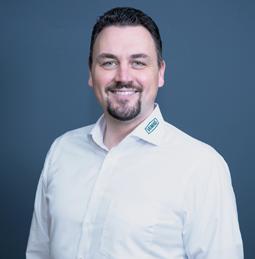
The BIC
The BIC, the Bakery Innovation Center, was put into operation by VEMAG in 2021. In addition to portioning machines, all upstream and downstream bakery process equipment is located on the premises. Kneaders are part of it, as well as processing technology, proofing cabinets, ovens and refrigeration technology. Cameras can be used to follow processes in the BIC online if required. The machine manufacturer makes the BIC available to customers for test runs or to try out new product ideas, as well as using it for its own development work, on-site training courses and webinars.
www.bakingbiscuit.com 04/2023 PORTIONING, FORMING, DOSING 30
”You can portion a huge range of products with a single line. I see our great strength in this flexibility. “
© VEMAG
Alexander Bressler, Product Manager Sales Bakery, VEMAG
Bake more, bake better with IPCO steel belt technology

Our solid and perforated steel belts have helped bakeries produce premium quality products for almost 100 years. Flat, straight, durable and easy to clean, they provide a baking surface that’s ideal for everything from rich, chewy all butter cookies to traditional biscuits and crackers.
The other reason for choosing IPCO is our global service capability, providing the reassurance of premium productivity too.
• High productivity wide belts up to 3500 mm.
• Maximum versatility – bake more on an IPCO steel belt.
• Energy efficient – lighter belt means lower carbon footprint.
• Belt only or full range of conveyor components.
• Installations, upgrades (mesh replacement), repair, maintenance and spare parts.
ipco.com/bake See us at IBA Munich · 22-26 Oct · Hall C1 Stand 120
A very special order
In the spring of 2023, Ölz der Meisterbäcker put its expanded production into operation. When it came to raw material handling, the Austrian plant baker relied on Zeppelin Systems for solutions.
By Denise
+Ölz der Meisterbäcker, headquartered in Dornbirn, Vorarlberg, is Austria’'s market leader and produces more than 100 different baked goods with around 1,040 employees. In 2022, Ölz generated sales of around EUR 240.2 million, up 12.8% from the previous year. The export share of the company, which is managed by the third generation of the family, is 43%.
When the plant baker started up its extension in Wallenmahd in spring 2023, two new production lines for yeast dough pastries, toast and sandwich breads also went into operation. For raw material handling, Ölz relied on a solution from Zeppelin Systems. This means that there are now three systems from the Friedrichshafen-based specialist in operation at the bakery in Wallenmahd.

“Ölz commissioned us with the complete raw material supply for the new hall, including a connection to the silos in the existing plant,” explains Ingo Pütz, Director Sales, Food Plants at Zeppelin Systems. “This was also a very special order for us – in terms of scope, requirements and schedule.” The plant manufacturer not only supplied individual components such as silos, screening machines, etc., but also took over the mechanical installation as well as the complete control scope including control cabinet construction and software development. It took just two years from kick-off to acceptance. The fact that such a large project proceeded quite quickly and smoothly was also due to Ölz’s thorough
preliminary planning. In addition, both project partners were able to draw on their experience with the first two plants.
”This was a very special job for us, too - in terms of scope, requirements and schedule.”
Organization is everything
Changing batches, different dosing accuracies of the raw materials as well as different container sizes require wellthought-out raw material management. Ölz set high standards for the new production lines at Wallenmahd. “The customer had very precise ideas at the start of the project,” recalls Ingo Pütz. What was required was a plant that was as compact as possible. The Zeppelin Systems engineers were involved in the planning at Ölz at an early stage and were able to coordinate with the building planner. “We jointly designed a 3D model of the plant in which we had already positioned all the equipment in great detail. And we were able to implement it almost 1:1 like that,” confirms project manager Roman Kreher from Zeppelin Systems. Another component of the order was a simulation of the processes based on the basic recipes. “From this, we gained some insights that were incorporated into the planning,” reports Denise Mohr, who had supervised the process engineering design of the plant since the beginning of the sales phase.
www.bakingbiscuit.com 04/2023 DOSING 32
Mohr, Project Planning Process Engineering, and Roman Kreher, Project Manager, at Zeppelin Systems GmbH, Rödermark/Germany
Ingo Pütz, Director Sales Food Plants, Zeppelin Systems
© Zeppelin Systems

YOUR
Stand 110 Halle B3
STEP INSIDE
FUTURE
The aluminum storage silos are almost 16 meters high, in which large quantities of flour, sugar and salt are waiting to be used. Special flour blends are in pole position in the station for medium components, ready to be mixed into the dough at any time.

”Together with Ölz, we designed a 3D model of the plant in which we had already positioned all the equipment in great detail. And we were able to implement it almost 1:1 like that.”
Individual requirements
Ölz stocks ingredients that are required in smaller quantities, such as seeds and kernels, in sacks. In order to be able to act as flexibly as possible with the frequently changing recipes, the employees weigh these small components manually. “The Zeppelin Systems experts adapted the concept for handling the small components to our requirements,” reports Walter Maurer, plant manager of the Ölz Bakery in Dornbirn-Wallenmahd. We wanted a user-friendly solution here, with which the employees can work error-free. This is particularly important for ingredients that only make up a small proportion of the recipe.” A highlight of the plant is located on the upper floor: mobile manual feeders, under which containers and scales are located. The
operator is shown via a screen what needs to be filled into which small ingredient containers. One floor below is the removal facility with a manual weighing station. “This mixture of 'manual and automatic' speeds up and simplifies the handling of the small components – and above all, the method enables high dosing accuracies,” explains the plant manager. To prevent employees from filling incorrectly, an RFID transponder chip is mounted in the base plate of the manual infeed chute. Only when this is positioned at the correct transponder is it released for filling.
Quality assurance has a high priority
In order to meet the requirements for a consistently highquality product, Ölz attaches great importance to quality assurance. Rotary screening machines, for example, allow grain sizes to be precisely verified. They are located directly below the silos for large components. This compact design saves time because the product can be transferred directly from the silo to the pneumatic conveying system. “We already stock sifted flour in daily silos,” reports Walter Maurer. “That pays off with the many different batches.” Container cleaning with a semi-automatic CIP system also contributes to the high quality of baked goods. In order to be able to trace all cleaning steps, the control system records the processes and stores the data.
The large bakery also relies on the expertise of Zeppelin Systems engineers when it comes to explosion protection: a bursting disc is fitted to the sugar silo as a structural

www.bakingbiscuit.com 04/2023 DOSING 34
Roman Kreher, Project Manager, Zeppelin Systems
© Zeppelin Systems © Zeppelin Systems
3D planning
THE FUTURE POWERED BY EXPERIENCE
AT IBA OCT. 22-26
MUNICH, GERMANY
Stand B1.150 & B1.170
In addition to meeting and exceeding current production needs, we look to the future of processing.
Our experienced and knowledgeable engineers and food technologists work with you to optimize end to end solutions.
BREAKTHROUGH TECHNOLOGY FOR BETTER BAKING
Auto-Bake F3 Oven - Daily Show Demos
Inline Vacuum Cooling System
Baker Thermal Solutions RapidBake Oven (electric or gas)
Burford Smart Seeder +
Escher AGV / Robotics Mixing Systems
Spooner Vicars FGR Roller Hydraulics
Stewart Systems Lubeless Viper Chain
Rack N Stack
MAP-PAK 20
Sveba Dahlen Artista Deli
HUNGRY FOR MORE?
UNLEASHING THE POWER OF NEXT-GEN BAKING

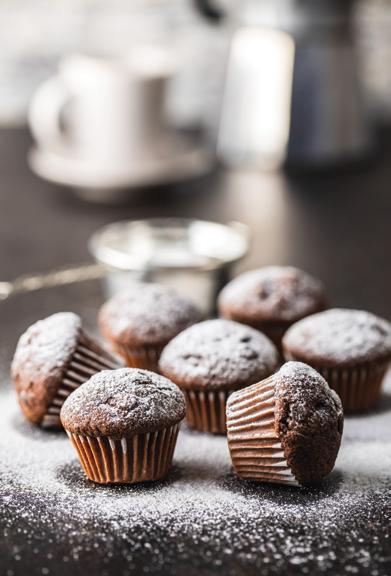
Breads | Buns | Cookies | Crackers | Cakes | Muffins | Pastries | Pies | Pizzas


LESS WASTE MORE IMPACT.
REDUCE GREENHOUSE GAS EMISSIONS
MINIMIZE WASTE
OUR BAKERY BRANDS
MINIMIZE ENERGY CONSUMPTION
OPTIMIZE WATER CONSUMPTION
FACILITY AUTOMATION & EQUIPMENT SANITATION BRANDS
protection system, and the same applies to the flour. This is required by the VEXAT – Ordinance on Explosive Atmospheres – in Austria.

A good collaboration
“We were able to contribute to the project our comprehensive know-how in the entire handling process from raw material reception, storage, discharge, conveying, preparation, dosing and blending to control,” summarizes Roman Kreher. For both companies, the new production facility in Wallenmahd is a showcase project. When asked what impressed him most about the construction of the new production lines, plant manager Walter Maurer replies: “It was the intensive cooperation, the regular exchange and the good teamwork among the project partners involved, the experts from Friedrichshafen, the building planner and the steel constructor.” +++

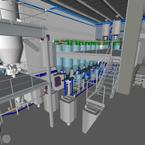

www.bakingbiscuit.com 04/2023 DOSING 36
”For the dosing of small components, we wanted a user-friendly solution with which the employees can work error-free. This is particularly important for ingredients that only make up a small proportion of the recipe.”
Walter Maurer, Plant Manager Dornbirn-Wallenmahd, Ölz
© Zeppelin Systems
© Zeppelin Systems
© Zeppelin Systems
Screening and discharge of the large components below the silos Small component storage and manual weighing
Center component weighing and 3D planning
Ingredients of your success

The Kornspitz® has been delighting bakers and consumers in over countries around the world for more than years. Pure enjoyment, thanks to high-quality raw materials and a high fibre content. More at www.kornspitz.com backaldrin.official backaldrin (official) www.backaldrin.com
EXHIBITOR HIGHLIGHTS, PART I It’s not a sprint, it’s a marathon!

Last time iba was staged in person, it provided a platform for EUR 2.1 billion in trade fair contracts. Five years later, anticipations run high for the industry’s first ‘official’ get-together in Europe since the pandemic. With exhibitors bringing their best and latest to the stand, we asked key industry players what news they are bringing to the Messe Munich, when the gates open to visitors for iba ’23 in October.
Heinen
Heinen will showcase its spiral technology with a live running system – a spiral freezer from the arctic a7 series, with 22 floors, a belt width of 760 mm and a total belt length of 384 m. “On this spiral system, we will show the innovations of our cleaning system PRO as well as our recently developed freezerfoamer ® PRO,” says Jochen Hottinger, managing director. “Of particular interest is the new form-fitting drive, in which the belt runs on the drum without slippage. This has the advantage that the belt runs completely smoothly and there is therefore no movement between the products,” he explains. Visitors can also learn about Heinen’s energy-saving fans for its freezers, which will be available soon on the market.
“Here, we try to achieve the Premium Efficiency Standard IE5,” Hottinger adds.



Heinen focuses on industrial bakeries for its developments, meaning high-performance, high-capacity machines. “Driven by the needs of this industry, we are always focusing on making the machines more intelligent, i.e. we will take away responsibility from the operator watching the machine and shift it into the machine,” says Hottinger.
KEMPF
KEMPF is bringing its comprehensive portfolio of trays, pans, coatings and racks to iba – including new product releases. The special trays of its new
group member, KeyBAKE, will also be showcased. Together, they can offer the full range of bakeware, said Guido Kempf, KEMPF CEO: “KeyBAKE brings deep knowledge in deep drawn- and special pans like bun trays, cake trays, muffin trays and customized tin sets. This is a very good addition to KEMPF’s portfolio, which includes baguette trays, perforated trays, peelboards, racks and high-performance, nonstick coatings.” KEMPF’s most requested products currently include trays and pans for fully automated lines, “lines in very precise and stable execution in combination with the best coating for the job,” Kempf adds.
“Sustainability starts in our production. Our new plant will be heated without any fossil energy sources. The roof will be covered with more than 9,000 solar panels. For our customers, sustainability means providing trays and pans that can reduce energy consumption in the bakery enormously as well as coatings with lower greasing requirements,” Kempf explains.
FRITSCH
FRITSCH will introduce the completely redesigned IMPRESSA bread at iba. For the upgrade, the company focused on the line’s hygienic design and a very compact footprint. “We will also present some technological highlights, especially in dough sheet production, but also in terms of end products and the flexibility of the line,” said Stefan Praller, Senior Director, Customer
© GHM www.bakingbiscuit.com 04/2023 ‘23 SPECIAL 38
Hall A1
365t
171 Hall A1
© Heinen
© KEMPF
111
Hall A2
Experience. The smaller PROGRESSA bread will also be presented, upgraded to produce an expanded product range. In order to offer customers more solutions, there will also be an area with MULTIVAC machines and the related products at the booth.

Industry trends FRITSCH is focusing on for its new developments include hygienic design, a compact equipment footprint and flexible, modular solutions. “In addition, we in the MULTIVAC Group continue to work consistently on Smart Services in order to support our customers in a predictive manner and to avoid unplanned downtimes. All of our industrial lines are now designed for this as standard,” Praller anticipates.
VMI
VMI will feature a comprehensive range of equipment at its iba booth, catering to small and largescale production, including automated mixing systems. “We aim to demonstrate the breadth of our technological capabilities, covering planetary mixers, batch mixers with removable bowls, bottom discharge mixers – both as standalone units and integrated into fully automated systems – as well as continuous mixing systems. All of these will be showcased at our booth, in physical form, or through a virtual reality experience,” VMI anticipates.
Two of VMI’s latest innovations will be among the highlights at the stand: a high-capacity fermenter and a new double-tool mixer with bottom discharge and temperature control.
Visitors can expect a range of engaging experiences at the stand. One highlight will be the ‘Innovation & Sustainability corner’, a dedicated space where visitors can immerse themselves in VMI’s technologies with the help of virtual reality gear. Details of automated mixing equipment can be explored, to better understand all processes.
Moreover, live demos will be staged at the booth, showcasing VMI’s IoT solutions. “These demos will provide insights into how this technology enables the monitoring of performance and indicators. Visitors will have the chance to witness the tangible benefits of our IoT solutions and gain a deeper understanding of how they can optimize their own operations,” VMI explains.
DIOSNA
DIOSNA will present smart, future-oriented solutions for the food industry in the areas of automation, dough processing and mixing. “Visitors to the DIOSNA booth will be introduced to the symbiosis of our Hygienic Design Wendel Mixer and trend-setting automation using Automated Guided Vehicles (AGVs),” DIOSNA specialists anticipate. In addition, its universal mixer from the Pharma division will be showcased, highlighting the wide range of possible applications in the food industry.

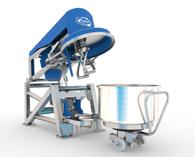
Visitors can also stop by the DIOSNA Bakery at the booth, which will not only present various bakery delicacies but through them, the advantages of pre-dough systems will be explained. DIOSNA’s service team will also be present at the stand, for any technology and operationrelated questions.
American Pan
At its iba stand in 2023, American Pan from Bundy Baking Solutions is preparing to exhibit a range of innovative baking solutions and new developments.
“We are proud to showcase our latest advancements in baking technology, including our state-of-the-art baking pans, trays, and related equipment. We will also highlight our commitment to sustainability by presenting eco-friendly solutions and our efforts to reduce environmental impact within the baking industry,” Jason Bowman – President, American Pan Europe & MENA, tells us. Since the last iba edition, the company has expanded by welcoming two new additions to the American Pan – Runex and Turbel –which not only broadened its expertise but has also allowed the company to establish facilities in Sweden, Germany and Turkey.

www.bakingbiscuit.com 04/2023 39 ‘23 SPECIAL
Hall A2 111
110 © FRITSCH ©
© VMI
Hall A2 340 Hall B1
DIOSNA
American Pan is planning interactive demonstrations and extensive product showcases to highlight their comprehensive baking solutions (details to follow on www.bakingbiscuit.com as they become available). “Our goal is to provide visitors with a unique opportunity to immerse themselves in our proprietary products, gain insights into the latest baking advancements, and interact with our knowledgeable staff,” Bowman adds, anticipating a “truly memorable” iba ‘23. The company is investing in cutting-edge materials and coatings that improve the performance and lifespan of its baking pans while reducing energy costs at the bakeries. “Our main R&D priorities revolve around developing technologies that empower our customers to operate efficiently and sustainably while servicing their customers in this dynamic and competitive industry,” he explains.
Kwik Lok
Packaging specialist Kwik Lok is preparing to launch new sustainable solutions at iba. Visitors can expect green and efficient solutions, from bag closures to printers. “Kwik Lok will be showing a host of new products from bag closures designed to support a circular economy and labels that use no adhesives, to machines and printers that offer higher efficiencies, and simple maintenance,” says Karen Reed, Global Director of Marketing and Communications.
Sustainability is the trend driving research at Kwik Lok; the company developed a new bag closing machine for bakeries with additional automation that will save operational time and avoid downtime, for example. In addition to its Fibre-Lok product, the company will also introduce a new addition to its sustainable product portfolio. Reed details: “Sustainable solutions that require less operational labor are the industry dynamics Kwik Lok has been focused on. Kwik Lok continues to prioritize our customers’ need to reduce operational disruption and help minimize labor needs.
Hansaloy
Hansaloy will have a full display of bread and bun slicing blades on display to slice all types of breads, buns and rolls. These include band slicing blades as well as reciprocating slicing blades. In addition, Hansaloy will have a display showing our depanning cups, clips and
belting. “Hansaloy continues to innovate these items as bakers’ requirements change,” Allen Wright, Vice President, says.


Koenig
At iba, Koenig focuses on increased production efficiency and will be launching “the most powerful line in the bread roll sector, in ‘Easy Clean’ Design”, the company anticipatesthe KGV EC bread roll line.


The motto for this year’s stand is ‘Koenig Five Senses’, which stands for the complete sensory experience of enjoying bread. At iba, “We want visitors to explore the world of baking with all their senses in the ‘Five Senses’ lounge, on the ‘Five Senses’ path and discover the endless opportunities of high-performance baking equipment on our booth,” Koenig details.
For iba, Koenig will focus on the continuous optimization of the machinery designs for improved flexibility, efficiency and hygiene. “With our newest equipment, we support bakers in energy efficiency savings, increased production output, flexibility in types of products and unprecedented hygienic design for quick daily cleaning, minimum wearing and reduction of downtimes,” Koenig says.
With the ISCORE Bread scoring system, Koenig dives into Artificial Intelligence (AI) for cutting breads and rolls. The system continuously adapts to product variability over time while maintaining an optimal rate of speed/ accuracy.
Several live demonstrations showcasing the highlighted equipment are scheduled at the booth, every day.
COATRESA
This year, Coatresa is introducing a new range of Testrong ® Coatings at iba, the Testrong ® PRO. Visitors to the stand will be able to see the bakeware and examine the coatings up close, with presentations set up in private viewing rooms, for an immersive experience. Also, “We will also be offering a meeting space where we will be able to understand our visitors’ needs in more detail, so we can offer custom solutions based on their requirements. And, last but not least, our visitors will be able to understand the manufacturing process we follow in
www.bakingbiscuit.com 04/2023 ‘23 SPECIAL 40
©
© kwik lok Hall B1 111 Hall B1 230 Hall B2 370 Hall B2 460 Hall B2 570
American Pan
©Koenig


















































order to make our customers’ ideas happen,” said Eduard J.
Castaño, Vice President of Marketing and Business Development.

Developing and improving specific coatings adapted to the priorities of each end product is one of Coatresa’s main R&D priorities. “We have our own R&D department that is constantly working on improving our Testrong ® non-stick coatings range, which is currently made up of more than 25 formulas, each one designed for a different type of dough,” he explained.

Keeping in mind the differences between various types of dough, and considering the new trend of glazing the buns for a more artisanal/brioche-like look, Coatresa “engineered a special coating system to allow the highest release of glaze flakes and ensures the best cleaning in the production lines,” Castaño added.
Albert Handtmann Maschinenfabrik
Visitors can expect demonstrations of a wide range of production methods for the processing of dough and many other fluid, viscous, firm, or chunky products. The systems used in the process will be exhibited in different versions suitable for artisan small-scale producers and start-ups as well as medium-scale producers or industrial enterprises. All systems are interface-capable and can be fully integrated even into complex line solutions.
Handtmann experts will demonstrate the production processes of dough dividing, dosing, forming and extruding at the trade fair stand, supplemented by digitalization and automation solutions. One exhibit for industrial dough dividing involves a VF 842 portioning machine, the SE 442-1 cutting unit with transfer to a conical molder as well as a WS 910 weighing system. “The Handtmann WS 910 advanced weighing system is optimally suited for weight checking and control in baked goods production,” the company explains.
Dough dividing, forming and depositing in a single step will be demonstrated using a FS 520 forming system and a VF 830 portioning machine. The system solution comprising the VF 828 portioning machine and FS 510

forming system will also be presented. It can be used for the production of a wide range of snacks (e.g., all variations of bars, bread chips, vegetable sticks, crackers, chinchin, pão de queijo, etc.)
Other exhibits on the trade fair stand focus on automatic cake production, hygiene accessories such as a new pre-clean nozzle for dry production environments and more. The Handtmann Inotec portfolio presented comprises mixing, grinding and emulsifying system technology, including cooking or cooling, for product preparation.
IPCO
IPCO is exhibiting under an overarching theme, ‘We Love Food’, highlighting the benefits that the company’s steel belts and associated equipment bring to the baking process and the quality of the end product.

IPCO’s new laser cleaning service will be launched internationally at iba. “Making use of high-power laser technology, IPCO has developed a portable system that removes burnt residues from bake oven belts significantly faster than other processes, and usually enables baking operations to continue uninterrupted on nearby ovens,” explains Marko Leber, General Product Manager, Food, IPCO. The company’s new laser cleaning system also offers environmental benefits by eliminating the use of powerful chemicals. IPCO’s services range from the supply and installation of solid and perforated steel belts to system consultancy designed to maximize productivity and oven reliability.
“The company’s global service teams can offer a comprehensive range of conveyor components and support end users through planned preventative maintenance,” he adds.
IPCO focuses on supporting the efficiency of the baking process, better hygiene and maximizing oven productivity, with its R&D efforts. The company contributes to the sustainability of baking facilities, with steel belts frequently reaching 20 years of working life. In addition, IPCO will highlight the energy savings that can be achieved using steel belts rather than mesh.
SOLLICH
SOLLICH KG will exhibit a wide range of solutions from its portfolio, including an enrobing machine type Enromat® M6-1050, equipped with a new, patent-pending solution for electronic reproducibility of the mechanical settings. It features a Thermo-Flow ®+ chocolate cooling tunnel. Also on display will be a Decormatic ® DC4 automatic decorating device, installed on a decorating belt with a Minitemper MT 100 for feeding the decorating
www.bakingbiscuit.com 04/2023 ‘23 SPECIAL 42
©
140
120
340 ©
Coatresa Hall B3
Hall C1
Hall C1
Handtmann ©IPCO
SMARTSPIRAL
VERSATILE SMART TECHNOLOGY & BELTING SOLUTIONS

Ashworth Bros., Inc. revolutionary “Smart Technology” products report real-time remote monitoring, and when paired with the Eye-Link belt provides the best of both worlds for your baking manufacturing facility.

SMARTSPIRAL®
Remotely monitor multiple spirals at different plants in real time.
EYELINK®
Versatile steel conveyor belts can be designed and manufactured to satisfy the most demanding of applications.

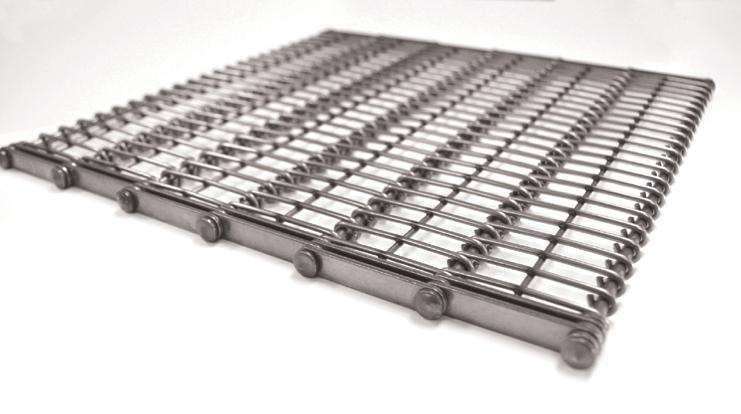
SMARTOVEN®
Monitor key metrics used to identify changes in equipment operating parameters.
us today to let us help
forward, Call +31 20 581 3220 or visit us at www.ashworth.com/bakingandbiscuit
Contact
you move your business
VIEW OUR RECENT SMARTSPIRAL® SUCCESS STORY!
EYELINK
SMARTOVEN
machine. Diverse decoration patterns are programmable.
A TE 1800 Turbotemper ® for feeding Enromat ® M6 enrobing machines will also be showcased. A TT 100 B Airo Turbotemper® for small capacities will also be presented, equipped with a heating reservoir tank and a feed pump, especially designed for tempering smaller chocolate volumes, with an integrated aeration system.
In addition, a complete chocolate coating Minicoater MC 420 machine will be on display with chocolate, followed by a LSK 420 Thermo-Flow ®+ cooling tunnel. “This machine is running very successfully at small and medium-sized companies setting new standards in the sector of minienrobing technology,” SOLLICH explains.
A CA 820 caramel enrobing machine, with a 820 mm belt width for enrobing wafers or biscuits with caramel will also be presented. With minor machine adjustment, it can be used with sugar icings.
“A highlight at the iba will be the Sollcocap depositing line for refining biscuits; e.g., fillings such as caramel, fondant, nut paste, jelly, milk, yogurt cream, or chocolate can be deposited together with ingredients. The performance of the system has been significantly increased and guarantees a high-quality production of sandwiching products,” SOLLICH explains.
AMF Bakery Systems

At iba 2023, AMF Bakery Systems showcases solutions that support sustainable baking, including oven technology and smart services. New developments for bread lines, pizza systems and soft bread and bun production will also be presented.

AMF ovens will present different solutions for sustainable baking, from its award-winning hydrogen-powered oven, to a suite of electric and hybrid ovens that can help bakeries transition from fossil fuels to greener options. These can be optimized with AMF’s data-driven, smart and digital services, the Sustainable Oven Service, which can provide real-time insights into
the baking process and setting recommendations based on the detailed data collected. Using this service, “gas consumption can be lowered by up to 20%,” illustrates Lex van Houten, Regional Marketing Manager, AMF Bakery Systems.
The company will also present its latest hygiene improvements for sheeted bread lines, incorporating “The new sanitary design and revolutionary new features for stressfree, gentle dough sheeting, reduction and handling of highly-hydrated doughs,” the specialist reveals.
For the production of breads and buns, AMF will present high-speed solutions for high-capacity production, as well as entry-level solutions.
The stand will include daily live demonstrations run by an award-winning Master Baker team, which will showcase the pizza topic lines, product handling and conveying systems, including robotics, high-speed slicing and bagging, and the Automated Guided Vehicles (AGV) for fermentation rooms. For this year and beyond, priorities at AMF revolve around sustainability – energy transitioning and savings, becoming CO2 neutral, baking sustainably, baking with green resources – as well as related services.
Reading Bakery Systems
Reading Bakery Systems (RBS) will be featuring its new sustainable and electric baking capabilities, continuous mixing technology, and innovative snack products made on their flexible production systems. Looking at industry trends, the company focuses on sustainable baking technology and automation.
Joe Pocevicius, Sales Director – EMEA, Reading Bakery Systems, comments: “We are building gas ovens that can easily be converted to electric in the future. Since process lines last for 30-40 years, bakeries can expect the machine they are buying today will be around in 2050. You can either buy green energy ovens now or make sure you have a plan to convert them in the future.” The Emithermic XE Zone, replacing direct gas-fired oven technology, is the company’s latest sustainable oven design. “The Emithermic XE utilizes Thermatec high radiant panels, convection baking, and electric radiant elements to bake the product, eliminating the need for gas burners. The Thermatec panels and electric heaters deliver a more balanced heat to the product, and impart the high radiant energy required to develop the flavor and texture of the crackers,” he explains.
Automation technology for the entire production process is also provided by RBS, including continuous mixing systems, automated dough handling, and forming and baking systems.


www.bakingbiscuit.com 04/2023 ‘23 SPECIAL 44
© SOLLICH
©AMF
110
Hall C2
Hall C2 320
©Reading Bakery Systems
“RBSConnect, our custom control system, facilitates better communication, coordination of the operations and the ability to collect and analyze data,” the specialist explains. These systems allow for real-time information monitoring. The RBSConnect platform offers a full suite of IIoT solutions for system controls, process optimization and management. Visitors can also learn about the snack systems, including flexibile lines for pita chips, seasoned pretzel bites and filled bars.
Rademaker
Rademaker will present innovations in its bread line and launch a new depositing solution. The Radini bread line will be displayed. This modular dough processing line has a capacity ranging from 400 to 1,200 kg of dough per hour. The Radilinq rack loader & unloader will also be presented. In addition, visitors can find inspiration in emerging bakery products and live product shaping demons trations.

With its bread line, Rademaker will showcase the latest exe cution of the make-up section. “A highlight is our bread rounder, which transforms the baker’s manual rounding technique into a flexible, industrial production solution,”
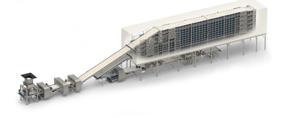
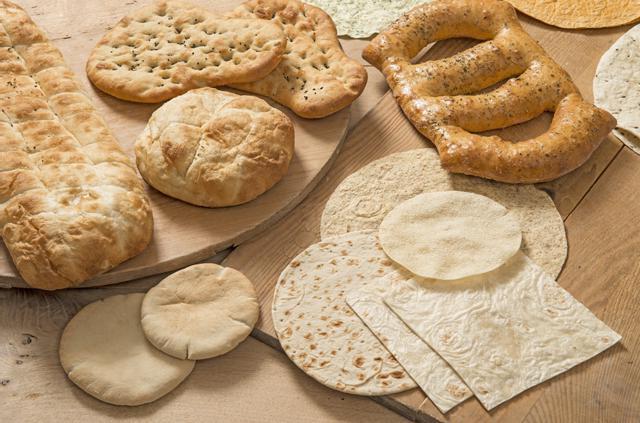
Rademaker anticipates. Another highlight of the line is the weighing conveyor, a system that combines a weighing solution with software algorithms that enable bakeries to accurately control the weight of their end products. The new, space-saving depositor is also a highlight at the stand, which can be used for a wide range of filled products, as it is capable of handling various smooth fillings. “Radilinq invites bakeries to experience the versatility of the system first-hand through continuous demonstration runs. This modular unit can be configured for rack loading, rack unloading, or a combination of both,” explains Rademaker. +++

www.bakingbiscuit.com 04/2023 45 ‘23 SPECIAL
ADVERTISEMENT
C2 350 ©Rademaker www.rademaker.com Tel: +31 (0)345 543 543 E-mail: office@rademaker.nl INNOVATIVE PRODUCTION LINES FOR BREAD PASTRY LAMINATED DOUGH FLATBREAD CROISSANT PIE / QUICHE PIZZA Different dough and crumb types possible Premium dough quality Dough thickness of up to 0,5 mm Best weight accuracy Your flatbread deserves a Rademaker system
Hall
iba summer is here!
We are just one summer away from the most anticipated bakery event of the hemisphere. With planning in full swing, Susann Seidemann , Exhibition Director, iba, shares the organizer’s insights into preparations, logistics, guides and tips ahead of the October 22-26 show.
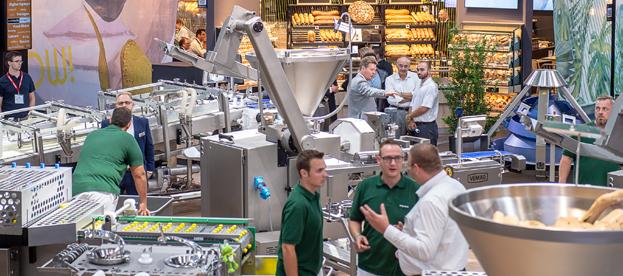
Baking+Biscuit International (BBI): At the start of an ‘iba summer’, what preparations are now underway? Please highlight the organization’s current work in the lead-up to the fair.
Susann Seidemann: Preparations for iba started about two years before the start of the fair. Over 95% of the space has already been booked and most exhibitors have already registered. However, potential exhibitors can still sign up before the fair starts, although, we recommend registering by August at the latest, due to the organizational time involved. During the summer, we are focusing on exhibitor support and any questions they have about their presence at iba, visitor communication and the highlights for visitors. The main issues are the framework program, lectures, speakers and also the Oktoberfest tent. We are also dealing with organizational details for the competitions and special areas such as the iba.START UP AREA and the iba.SPEAKERS AREA.
BBI: Several new features were announced for this year’s show – who should mark which in their agenda? What industry segment do they each cater to?
Seidemann: It is important to us that we do not highlight any segments separately. Our focus topics – food trends, artisan bakery, health and sustainability as well as digitalization, turnkey solutions and quality management – are considered across all areas. In this way, we want to encourage people to learn from each other and to think outside the box. These focus topics are the issues that are currently influencing the industry. A new feature is the iba.START UP AREA supported by Puratos, for example. Anyone who wants to discover new trends should make a note of this. The space is intended for national and international
start-ups. It has presentations across all sectors. The focus topics will be addressed in these speeches.
One important new feature is that the site plan and the halls have been reorganized for 2023. There are four sections: production technology and equipment, raw materials and ingredients, artisan bakeries and packaging technology. Our aim is to provide a clear overview. Visitors will find the orientation easier, and exhibitors will reach their target group more precisely. Artisan bakery plays an even more central role at iba this year, which is why it will have its own hall. It will be one of the focus topics. The Zentralverband des Deutschen Bäckerhandwerks e.V. (German Bakers‘ Confederation) is also organizing special tours that will highlight artisan bakeries. And the iba.ACADEMY is focusing on this, too: at the iba.ACADEMY, you can learn how to make traditional German Stollen Nuggets and pretzels and at the end you will get a certificate! The seminars will be held in English. There are two courses per day, in the morning and in the afternoon.
BBI: What changes have been made in the organization of the fair in response to the pandemic?
Seidemann: We are very pleased that we will be able to hold the fair again without restrictions and in the tried and tested format. We are being agile and flexible in organizing iba. We are addressing the needs of the market and putting the spotlight on topics such as sustainability and energy prices. We are displaying the current market and helping to find solutions.
In times of virtual iba offers, we have learned when supplementary digital offers and opportunities make sense as an addition to the live event. For example, the new iba.

www.bakingbiscuit.com 04/2023 ‘23 SPECIAL 46
+
© GHM
UNIVERSE brings together supply and demand for visitors and exhibitors on the iba website in the best possible way and thus enables a targeted visit. Digital searches make it easier for iba fans to plan their visit as exhibitors can show their products and content here. Visitors can filter by topic, such as food trends, and get relevant information displayed – from presentations to exhibitors’ products which interest them. In addition, the most frequently searched-for content appears at the top and at a glance.
Recently, and for the first time at iba 2023, interested parties will receive e-mails tailored to their needs with suggestions about iba – the keyword here is marketing automation, something we have invested in to create an even better experience for our community. We think of exhibitors to the same extent, because through the virtual iba we have learned how important lead tracking is: ‘Who are my contacts? Who came to see me?’ iba lead tracking simplifies the process of approaching and acquiring customers at the fair. Lead tracking is important on-site and on iba.UNIVERSE.
New iba, new layout
BBI: Please explain the thematic layout of the halls this year. Seidemann: The division of the 10 halls into these four sections is new: production technology and equipment, raw materials and ingredients, artisan bakeries and packaging technology. The structure is reorganized because, in the past, the halls were mixed. Now, the range of iba and its exhibitors is bundled according to the key areas of interest to visitors: this way, visitors have a better orientation and exhibitors can better reach their target group. Another new feature is the separate hall for artisan bakery.
BBI: Iba is currently 95% booked. What is the area assigned for iba 2023? Please compare it with the previous edition.

Seidemann: At the moment, 870 exhibitors are registered, of which 74% are international and 26% are national. Overall, we are expecting about 900 exhibitors. Due to full trade fair calendars and the size of iba, 10 halls will be available at the desired location in Munich and at the chosen time in October 2023, instead of the 12 halls of previous years. We worked together with our customers to make the best use of the slightly smaller space and we are all happy with the outcome: the quality and the offer remain the same. More than 95% of the space is already booked, the industry has a great appetite for iba and even the latecomers don’t have to be waitlisted yet!

BBI: How should visitors plan their trip to Munich and to iba, what recommendations can you share with us?
Seidemann: We recommend planning your arrival and booking a hotel well in advance. You should allow plenty of time to explore iba – and for evening events and networking. In keeping with the fair, there will also be the opportunity for journeys of discovery into the universe of German bakeries! Tours of bakeries in Munich and the surrounding regions are organized by the Landesinnungsverband für
das bayerische Bäckerhandwerk (Bavarian Bakers’ Guild). Another idea is sightseeing in Munich and, of course, having breakfast at one of the local bakeries. A visit to the Oktoberfest tent at iba is a great recommendation: simply join the party and network in a dirndl or lederhosen!
Special areas and events
BBI: In addition to the solutions exhibited, iba also provides a platform for knowledge sharing. What agenda highlights and interesting discussions should be noted? Are there registration requirements, or the opportunity to view them online/on request?
47 ‘23 SPECIAL www.bakingbiscuit.com 04/2023 ADVERTISEMENT Markenqualität und Frische aus Tradition. The Nut specialists KOENIG Motiv3 91x53.qxd 07.02.2007 11:23 Uhr Seite 1 · Almond- and Hazelnut-Products · roasted, sliced, diced and slivered · Sugar–coated and salted Products · Specifications KOENIG BACKMITTEL GMBH & CO. KG • Runtestr. 22 • D-59457 Werl Tel. 02922/9753-0 • Fax 02922/9753-99 E-Mail: info@koenig-backmittel.de • Internet: www.koenig-backmittel.de Quality-brand and freshness with long tradition
© GHM
Susann Seidemann, iba director
Seidemann: iba 2023 has special thematic areas and many highlights! For example, there is the iba.SPEAKERS AREA, a knowledge and networking area with presentations and discussion rounds. Another new feature is the iba.START UP AREA for innovation and experience, organized with a strong partner, Puratos. This has space for national and international start-ups, pitches, networking and content design with a strong partner. A highlight is the iba.ACADEMY, where participants learn how to make original German Stollen Nuggets and pretzels. Registration is required for this at www.iba-tradefair.com/en/messe/highlights/iba-academy. Another highlight is certainly the iba.UIBC CUP, a showcase of internationally renowned, top-level bakers. Awards ceremonies are held at iba.FORUM – such as the ‘Bundesehrenpreis des Deutschen Bäckerhandwerks 2023’ (National Award of Honour of the German Baking Trade) in cooperation with the German Bread Institute. Other competitions also include the ‘Baker of the Year’, the ‘Golden Walnut Award’, the ‘iba.UIBC.CUP of Bakers 2023’ and the ‘iba.UIBC CUP of Confectioners 2023’ as well as the ‘German Championships of Master Bakers’. The iba.BAKERY TOURS, tours of bakeries in Munich and the surrounding regions, are certainly a must. Registration is required for this at www.iba-tradefair. com/en/messe/highlights/iba-academy.
BBI: How does the organization maintain and build new connections, between two trade show editions – among bakeries and with potential exhibitors? How has this been maintained over recent years, with the event being postponed?
Seidemann: To network the industry internationally, we held iba.Connecting Experts, a digital networking platform, twice in 2021. Here, we presented new innovations and gave lectures. The networking platform has also kept us in touch with the industry.
In addition, we maintained contact with the baking industry in person over the past year and a half. For example, we took part in events such as the Association of the Baking Industry (VDB), Association of German Plant Bakers, BEMA and ABA and Baker of the Year and Marktkieker. There were also lots of trips abroad, association meetings and the TIA Conference (Tortilla Industry Association). In addition, we visited exhibitors – we were present at FEDIMA and the UIBC Young Bakers Cup as well as at the UIBC Congress. This is how we keep in close contact. It means we are very tightly bound to the market and know what is important to the industry! There is a lot of interest from the market to finally experience iba live again.
BBI: How does the communication channel within the iba community stay open – online and offline? And what are some of today’s topics in this ‘newsfeed’?
Seidemann: iba.UNIVERSE (www.iba-tradefair.com/en/ exhibitors) supports interaction within the iba community –here, visitors and interested parties can obtain information
in advance and prepare their visit to the trade fair even better before and after! We also use the iba channels via LinkedIn, Facebook and Instagram. We take the community with us and show what is influencing the baking industry, such as trends, or report from ‘iba on tour’. Offline, we are in direct exchange with the market, with visitors and exhibitors as well as the media at numerous industry events. We show an interest in what is happening on the market. As a cooperation partner, we are on-site at the ‘Baker of the Year’ event and IBIE, for example. In the newsfeed, we highlight the focus topics like food trends or innovations such as the iba.START UP AREA. This is about trends in the industry and topics such as sustainability, artisan bakery, or iba highlights.
”We will be asking the most important questions. How does each country deal with individual situations? What are the new trends and innovations or further developments? What do others do for the next generation and how do they deal with energy resources? But iba will also address social, individual change – from traditions to snacks and the out-of-house market. Shared cultural traditions are shifting, for example, due to the changing global economy and new jobs.”
Susann Seidemann, Exhibition Director iba
BBI: How were the upcoming dates selected, after 2023? And what does the one-off Dusseldorf location entail, for the organization as well as for all attendees?
Seidemann: As the world’s leading trade fair for the baking and confectionery industry, iba unites the sector at regular intervals. Due to the pandemic, iba was moved to autumn 2023; the gap until the next regular iba date in 2027 would have been too long for the baking industry. Together with the Zentralverband des Deutschen Bäckerhandwerks e.V. (German Bakers‘ Confederation) and in close consultation with the market, we as the organizer, therefore, decided to bring iba back on a shorter cycle, to spring 2025. iba thus remains the international industry meeting place, trendsetter and platform for innovations and exchange. Düsseldorf has already proven itself as a location in the past: with Düsseldorf, we have a location where we have already successfully organized iba over many years and which the industry is familiar with. We would like to build on this success in 2025 and are looking forward to opening the event year of the baking industry as a world fair from May 18 to 22. Düsseldorf is also a major city with an airport and good connections. iba then returns back to Munich, to its original cycle and timing, in the autumn of 2027. +++

www.bakingbiscuit.com 04/2023 ‘23 SPECIAL 48
1000+ INSTALLATIONS WORLDWIDE DIRECTDRIVE™ SYSTEM

When Intralox invented the original low-tension spiral conveyor solution in 2012, it raised the bar for spiral technology beyond the reach of other belting manufacturers.
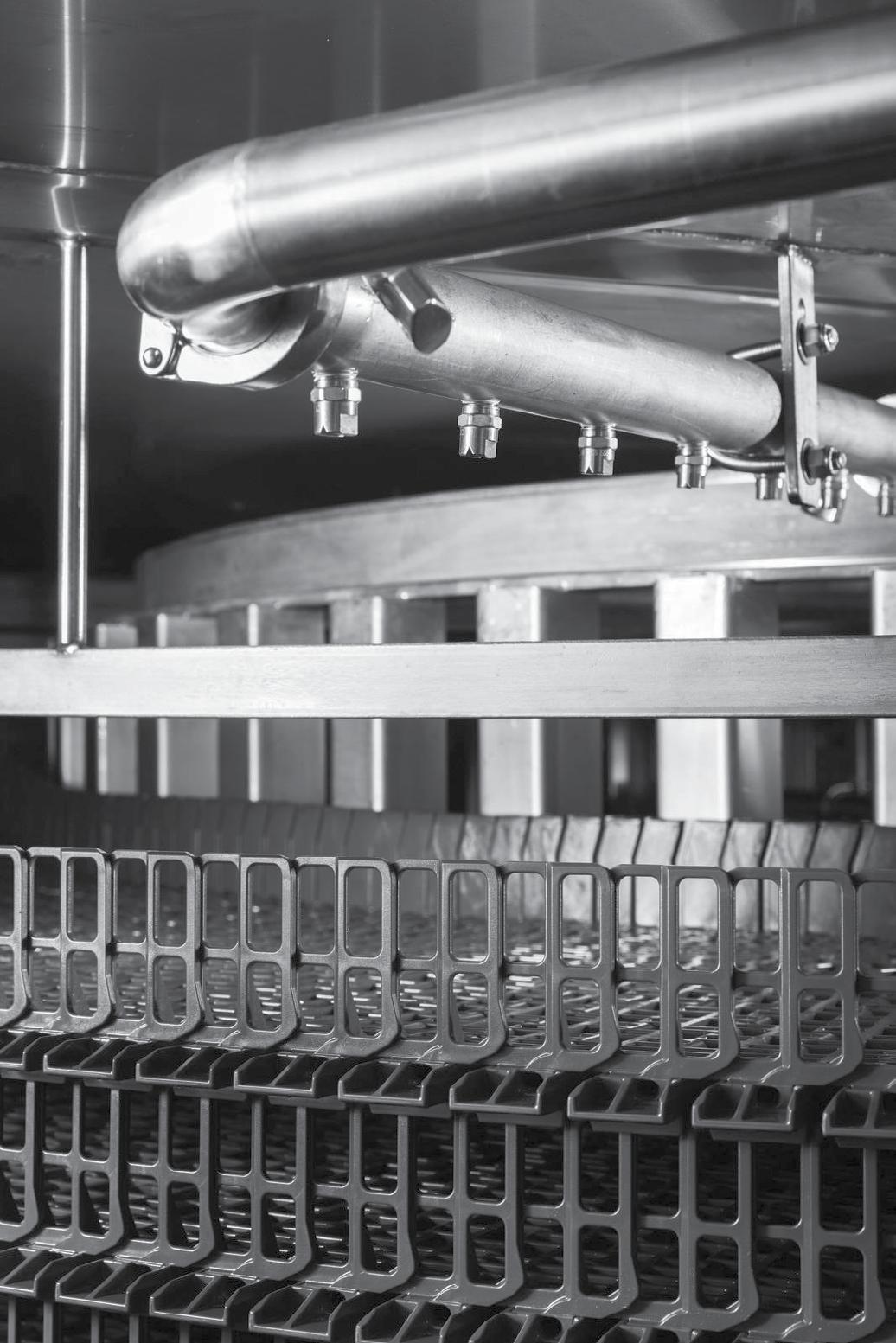
The One and Only DirectDrive System delivers:
Improved production
Reduced maintenance
Simplified sanitation
Scan QR code to see it in action.

How to scale up artisan bread production
Better-for-you preferences also apply to bread. Several mixing options help increase production volumes while providing goods that still feel and taste artisan-made.
+The demand for
healthier
options in baked goods continues to rise, and the COVID-19 pandemic has only intensified this trend. Consumers are increasingly seeking artisanal products that are made with simple, clean, and high-quality ingredients. Bread is a prime example in this category. To meet this growing demand, both retail and wholesale bakeries are turning to automation to scale up their production of artisan bread while maintaining the desired level of quality.
The process of making artisan bread presents unique challenges compared to mass-produced bread. The incorporation of liquid preferments, longer fermentation times, and precise dough management require careful attention and expertise. However, the advancement of automation technology has made it possible to overcome these challenges and streamline the production of artisan bread.
Automating the mixing process
Automation plays a crucial role in maximizing the output of artisan bread. By automating the mixing process, bakeries can achieve a higher standard of food safety and establish organized process control. This not only streamlines production but also reduces the number of hands required to handle the dough, minimizing the risk of contamination.

Careful process management and hygiene
Producing artisan bread involves a unique process that integrates liquid preferments and sourdough. Unlike typical pre-packaged loaves found in supermarkets, artisan bread requires less processing and aims for highly hydrated dough with reduced mixing time. However, the addition of
yeast and preferments adds complexity to the mixing process and increases the dough preparation time. Therefore, careful management of the mixing process is essential to develop the desired flavor, texture, and shelf life.
One of the challenges is to ensure a minimal increase in dough temperature during mixing. This is possible by optimizing the design of the mixing tools and tanks specifically for premixing, kneading, and fermentation with a precise tool shape, diameter, and position inside the mixing bowl.
Repeatability and accuracy
To achieve consistency in artisan bread production, bakers are able to leverage automation and process programming tools. Through automation, every step of the process, from fermentation and sprouting to degassing and yeast introduction, can be carried out accurately. Bakers can maintain high-quality control and consistency across each batch.
Increasing productivity
For bakeries aiming to produce large quantities of artisan bread, utilizing buffer tanks during fermentation, managed by an automated monitoring system, is highly beneficial. This approach enables the implementation of batch technology, which is well-suited for the complex and time-consuming processes of mixing and fermentation. By adopting batch technology, bakeries can achieve high productivity rates, ranging from 15 to 16 bowls per hour, and establish scalable processes.
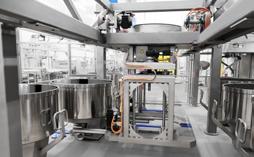
Streamlining transfer and cleaning
To optimize the larger assembly line, a solution developed by VMI incorporates a linear bowl transfer system that automates the movement of mixing bowls from ingredient ©
www.bakingbiscuit.com 04/2023 PRODUCTION 50 MIXING
VMI © VMI
dosing and mixing to resting time – if required – and downstream processing equipment. The system also transfers the mixing bowls to the cleaning-in-place (CIP) cleaning station. This feature is particularly relevant as equipment cleanability minimizes downtime during product changeover.

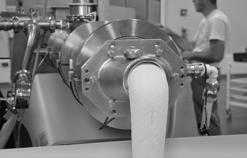
Optimizing the assembly line


In addition to automating the mixing process, emerging technologies enable the integration of other essential steps, such as premixing, fermentation, and kneading. For instance, VMI's horizontal premixer allows the initial homogenization of the mixture, which can then be transferred directly into the continuous mixer or buffer tanks for fermentation, the company explains. Simultaneously, other tanks can feed the kneader. VMI's VERYMIX and CONTINUUM continuous mixers further automate the flow management, facilitating resting phases or transferring the dough to the assembly line, while also reintegrating any dough scraps.

While artisan bread may have traditionally been associated with handcrafted techniques, automation offers a solution that balances efficiency and quality. By embracing automated food processing equipment, bakeries can achieve high productivity rates, maintain control over complex processes, and deliver artisan bread that meets consumers' expectations for taste, texture, and simplicity.



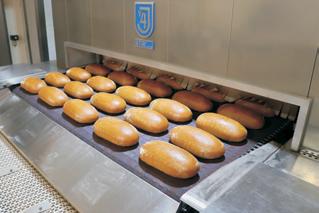
ADVERTISEMENT PRODUCTION
© VMI © VMI
+++
Les tartes sont magnifiques
Some of the oldest patisserie creations are also an undisputed dessert staple: pies and tarts. As they are continuously evolving, various techniques can perfect product processing in industrial bakeries, preserving the artistry of the skilled patissier.

+Tarts are often an interesting reflection of local cultures, combining different types of doughs with fillings, savory or sweet. They can be either open (tarts) or closed (pies) – or partially covered with a lattice. Even more flavors and textures can be brought to the creations after baking, by adding jellies, fruits, or meringue. The result: virtually endless possible combinations. “For industrial production, the baking support used is very important; whether made of aluminum or a different material, they will support the pie or tart as it travels through the various steps of its production and will sometimes be a part of the final packaging,” explains Loïc Le Denmat, patisserie expert, MECATHERM. He has been sharing know-how on preparing various specialties via his ‘Ask Loïc’ YouTube video series, one of which is dedicated to pies and tarts.
Baking is the key step when the textures are “brought to life”, as Le Denmat says. The challenge: achieving a crispy crust and perfecting the final color, while preserving the delicate fillings. All kinds of creamy fillings can be used, with any seasonal or regional fruit. With this variety comes the need for flexibility and accuracy in production, especially so when dealing with natural ingredients, which require very precise process parameters. For this a precise oven is key. The M-TA oven, for example, is especially suited for baking tarts, because of its flexibility that can match the wide diversity of recipes. The Mecapatisserie line, moreover, was designed to optimize industrial performance when manufacturing tarts and pies. MECATHERM’s Xavier Gotti, Product Manager, Oven, and François Retailleau, Product Manager, Line, explain how to perfect tart production, for any recipe.
Accurate industrial baking
The answer to perfecting the baking curve required for these delicate products comes from the M-TA oven’s modular design, in which each independent module can have different baking parameters set: baking may start with a high temperature and lower it later in the process, depending
on the product. For maximum flexibility, there are six possible options for heat transfer, the specialists explain:
+ Top convection and bottom convection
+ Top radiant heat and bottom radiant heat
+ Top convection and bottom radiant heat
+ Top radiant heat and bottom convection
+ Top convection, top radiant heat and bottom convection
+ Top convection, top radiant heat and bottom radiant heat
Each heating mode can be selected per module, so more radiation can be used at the end of the baking process if the product’s color should be further enhanced, for example, or convection can be selected at the beginning when more power is needed, for volume. Convection at the end of the baking helps shorten baking times. All parameters can be adjusted to closely follow the requirements of the tart’s recipe. Products using natural ingredients, for example, need particularly precise adjustments in terms of flow, temperature and humidity rate – for each module they travel through in the baking process. “An important point is that steam can be adjusted in the chamber to ensure a good humidity rate during baking,” Gotti highlights. Adaptability is particularly important when making fruit tarts or pies: for example, strawberries are added to the already-baked crust, and then sprayed with a jelly/glaze that protects the fruit, whereas in the case of apple pies, or tarts, the baking process is entirely different, as the fruit will go into the oven together with the crust. “This helps when using seasonal products as well as with the baker’s signature products to give a unique look. All can be achieved by changing the oven settings automatically, according to the recipe,” Retailleau also points out. A strong point of the M-TA oven, in this regard, is that it can combine heating modes in widely different ways, using radiation and convection from the top and the bottom of each module. Achieving different baking products (even when starting from the same recipe) can even include different contrast colors of the apples, just by changing the type of heating: using only or mostly radiation heating will result in a high color contrast
www.bakingbiscuit.com 04/2023 PRODUCTION 52
© ADOBE STOCK (#615666202)
between the top and the middle of the apple slice, for example. Using only convection, the color will be more even, and when both are combined – fruit or lattice colors can be nuanced as desired. The goal of the M-TA’s design was to provide all the tools for bakers to be able to design their own, unique products, by finetuning the baking parameters, the specialists add.
Complex equipment, simple process


MECATHERM’s tart and pie lines start with the oven and cover all subsequent production steps, including cooling and freezing. Filling stations can be set up before and after the oven. Products are automatically conveyed along the line, to simplify operations. Flexibility and frequent product changes are reflected in the design of the Mecapatisserie line. Since products running on the line can be switched even after a few hours, the line can therefore accommodate fast recipe changeovers, so that the oven is ready for the new products while the previous type of tarts or pies are still going through the final process stages. Recipe management is essential, to ensure the correct parameters are applied to the right products. The equipment incorporated in the Mecapatisserie is designed to support such fast changeovers.
Having comfortable space for operators was also considered, particularly for bakers who prefer manual handling of certain steps of the after-oven processes. “When making a certain type of seasonal product for two weeks every year, it’s not usually worth having a dedicated, automated system for it. For such products, depositing can be done manually, for example,” Retailleau illustrates.

A Mecapatisserie line is customized starting from the bakery’s current product list (but, new products can also be accommodated later on). All the equipment on the line will be adapted around those products, following trial runs at MECATHERM’s demo center. Technology is then sized to match the required production capacity. For cooling and freezing, solutions such as the MVD cooler and the MVS freezer can be included, both featuring a modular vertical system, with a dedicated cold tray circuit.
Its flexibility is not limited to pies and tarts. It can also be used to produce brownies, lava cakes, financier cakes, madeleines, muffins, twinkies, sponge cakes, choux buns, eclairs, cheesecakes, macarons – and the list can continue, offering bakeries a wide range of options for expanding their portfolio with new creations. +++

53 PRODUCTION www.bakingbiscuit.com 04/2023 ADVERTISEMENT
Fit for the crisis, well equipped for the future
Complex challenges ask for agile solutions that provide answers for today and reliable tools for the long run. Advances in digitalization are promptly delivering building blocks to tackling any number of issues, while focusing on sustainable, innovative business priorities. Smart financing goes hand in hand with digitalization.
By Klaus Meyer, Siemens Financial Services
From today’s perspective, the pandemic was certainly not the greatest challenge imaginable for the baked goods industry. The continuing strains on supply chains, in addition to increased energy prices and the reluctance of inflation-stricken consumers to spend are demanding answers from companies. Against this backdrop, fundamentally familiar solutions such as process optimization, digitalization and increased energy efficiency are gaining in urgency. This applies all the more to the intelligent financing of the necessary investments.
Energy consumption, costs and CO 2 emissions down, efficiency, productivity and profitability up: the basic recipe for resilience during times of crisis is simple. Unfortunately, this cannot apply for implementation, even though a new generation of digital technologies is enabling large-scale bakeries to network all the data points (e.g., sensors) of their various plants and connect systems to synchronize workflows and thus obtain a holistic overview of a factory’s performance. Networking makes it possible to identify problems and efficiency gaps more quickly and to initiate continuous improvements up to and including further
automation of production processes. The latter factor is particularly suitable for reducing personnel costs and mitigating the consequences of the shortage of skilled workers.

Potential through digital technology
The way to greater efficiency, greater flexibility and sustainable cost reductions in the bread and baked goods industry is, therefore, through end-to-end digitalization of production. Only when all processes are optimally interlinked and all plant components communicate reliably with each other can companies in the baked goods industry produce more and conserve resources at the same time. With the optimum technical equipment, problems that arise in the production process can be solved more quickly, defined process parameters can be better adhered to, raw material losses and energy consumption can be minimized, and cost efficiency and productivity can be increased.
Even relatively small improvements in the areas mentioned can make significant contributions to improving the operating result. For many bakery manufacturers, however, the
www.bakingbiscuit.com 04/2023 DIGITIZATION & FINANCING 54
+
question is how they can invest in technological improvements with optimism despite uncertain markets. The fact that companies continue to be reluctant to use their own funds further hinders the necessary investments in technology and digital solutions.
But time is running out, as a recent study by Siemens Financial Services shows. According to the study, the window of opportunity for gaining a competitive advantage by investing in digitalization is closing. The ‘tipping point’ is in about five years. From then on, companies will likely find themselves trailing behind and will have to engage in a laborious race to catch up.
decisions, the financier can also offer a framework agreement that optimally accompanies step-by-step digitalization.
Because the timeframes for technological innovations and upgrades are becoming shorter and shorter, financing should offer the flexibility to adapt the equipment to new requirements and developments during the financing period. Such upgrades involve modernizing the technology platforms with new hardware and/or software. Competent financiers can also include the software element in an overall financing package.
Changing technology or production platforms also presents challenges that the right financier can mitigate – for example, by suspending installment payments until the new systems are actually productive and begin generating revenue.
Answers in flexible financing
What can technology providers and financiers do to facilitate timely investments in digitalization and automation for bakery manufacturers? From Siemens’ point of view, this calls for solutions that enable companies to digitize and automate in a gradual way and, to this end, include a tailored concept for intelligent financing. Such financing enables the acquisition of technology and equipment in a way that is financially sustainable and tailored to the specific business and cash flow needs of the companies looking to invest.
This sounds logical, but it puts a lot of pressure on the financier. For a financing solution to be able to offer such a degree of sustainability and adaptation to typical industry and customer-specific requirements, its provider must have deep insights into the world of baking. They must know the technologies used there, the markets, the applications and the competitive situation – and this is likely to apply to only a few specialized financing providers.
Based on this knowledge, these specialized providers can match the financing period and terms to the expected benefits that will accrue from the technology. Savings or profits from access to the technology are used to fund the monthly payments, allowing the technology to become cost-neutral to the user from the start. Future savings are effectively used to fund the current investment without having to commit capital.
In addition, ancillary costs, such as those required for maintenance, are often covered in a bundled monthly payment. To enable rapid purchase and implementation
A close relationship between financing and technology providers is also advantageous. Siemens Financial Services (SFS) maintains that it uses this close relationship to offer buyers of Siemens products tailored agreements such as extended payment terms of up to 180 days. Another advantage is the bank independence that specialized financiers like Siemens Financial Services offer. This gives businesses access to additional funding without impacting existing bank credit lines. This creates economic freedom of movement for sales initiatives, hiring skilled workers, or logistics measures. The use of flexible financing models enables bakery manufacturers not only to adjust their payments according to the liquidity profile but also to fix guaranteed interest rates over the entire financing period. Payments can also be aligned, where appropriate, with strategic goals such as waste reduction, increased productivity, energy efficiency, etc. And last, but not least, flexible financing helps to take advantage of short-term tax breaks and depreciation and amortization and to design them freely.
Conclusion: technology and financing to secure the future
Technological excellence alone is therefore not enough to make the bread and baked goods industry fit for the future. Only the combination of innovative technology and flexible financing offers companies a sustainable way to modernize, automate and digitally transform their processes. It is high time to start taking the first steps on this path. +++
About the author
Klaus Meyer is the Head of the Commercial Finance business of Siemens Financial Services in Germany and Chairman of the Managing Board (CEO) of Siemens Finance & Leasing GmbH; fub.de@siemens.com
55 DIGITIZATION & FINANCING www.bakingbiscuit.com 04/2023
”According to a recent study by Siemens Financial Services, the window of opportunity for gaining a competitive advantage by investing in digitalization is closing. The ‘tipping point’ is in about five years.”
Klaus Meyer, Siemens Financial Services, Germany
How German craft bakers survived the pandemic
The bakery market has been shrinking for years, triggered by the growing range of bakery products in other segments of the food retail sector, as well as in the snack and catering sector. The performance of the German market in 2019 is reviewed in the light of its post-pandemic evolution.
By Prof. Dr. James Bruton
This study is based on the annual financial statements and management reports of 101 larger, predominantly artisan bakery companies published in the Federal Gazette and provides a detailed overview of the economic situation of the industry, relative to company sizes. The year 2019, before the COVID-19 crisis, is compared with 2020, when the first pandemic wave of illness led to widespread economic problems – and became an existential issue for many. Generally, 2020 is also the year for which published financial statements are available, so the data represents the current state of reporting. In the case of a different financial year, i.e. with a balance sheet date during the year, the financial statements with the financial year ending during 2020 were used as a basis. These only relate to a handful of companies.
The advantage of using published data certified by auditors is obvious. Admittedly, it should be noted that companies not subject to public disclosure requirements (e.g. partnerships in the form of a KG or OHG or as a GmbH & Co. KG with at least one natural person as a general partner) cannot be included. The same applies to micro-enterprises, which only have to publish a balance sheet and no profit and loss account, so these are also missing from the sample. This finding is important because about 80% of the businesses generate a turnover of less than EUR 1 million, with half of these generating less than EUR 250,000. In this respect, this is not a representative study in a scientific sense. Nevertheless, the large number of companies of all sizes in
conjunction with the comprehensive analytical tools used here are suitable for reliably depicting the market situation at the turn of 2020.

There is another special feature that needs to be taken into account: the bakery companies analyzed have different business models. The classic concept of a craft bakery is that of a company that produces for its own sales outlets. With the concentration that has prevailed in the industry for many years, there is often a need to manage a large number of sales outlets. Today, companies with less than about two dozen sales outlets are already almost leading a niche existence. The pressure to expand has now led to franchising models, in addition to supplying their own outlets and cafés. Moreover, there are also companies, usually large operations, that ‘only’ bake and deliver to food retailers. Such companies cross the border to industrial production and the concept of craftmanship fades into the background while the idea is nevertheless held prominent for reasons of marketing. In selecting the companies for this study, an attempt was made to include those companies that, grosso modo, still embody the art of artisan baking. Some company figures, such as staff size, can only be interpreted correctly against the background of the business model.
Furthermore, it should be noted that the data for the study had to be transferred manually from the Federal Gazette. With over 5,000 data records, transfer errors can therefore never be completely ruled out. However, the control
www.bakingbiscuit.com 04/2023 MARKETS 56
+
procedures used guarantee an error rate of less than 1%, so that the general statement is not limited by individual errors. On the other hand, no liability can be assumed for possible errors in individual cases.
The development of the bakery market
The bakery market has been undergoing a consolidation process for years, triggered by the growing range of bakery products in other segments of the food retail sector, as well as in the snack and catering sectors. Consolidation means a shrinking number of companies are striving to operate more effectively and efficiently with an annually decreasing number of employees. This is accompanied by strong growth pressures and a high degree of ‘chainisation’, with industry sales climbing steadily upwards despite a declining number of companies and employees. The result is a widening gap as shown in Figure 1.
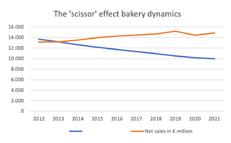
On the one hand, we see a turnover trend here that has
been steadily rising since 2012, until a slump caused by the pandemic set in, which, however, quickly recovered. On the other hand, the gap between turnovers and the number of operations has been widening continuously since 2013. A look at the following Table 1 reveals more details.
In the 10 years between 2012 and 2021, the number of companies decreased by 3,701 – from 13,666 down to 9,965, a decrease of 27.1 %. From 2019 onwards, the curve slightly flattens: the year-on-year decline in 2019 = 4.0%; 2020 = 3.0%; 2021 = 2.1%. Perhaps a gradual calming of the consolidation process is emerging here or the development is due to the pandemic. After all, the percentage values are comparable to those immediately after the financial crisis in 2010 and 2011. We will only see the cause in retrospect after a few years.
Parallel to the decline in the number of enterprises, the number of employees and apprentices also declined. Until the COVID-19 crisis, the number of employees declined by 1-2% annually. With the onset of the pandemic, the decline shot up to 4.0% in 2020 and even to 5.7% in the following year. This development seems to be crisis-related. Apprenticeship numbers look even bleaker, probably due to difficulties in recruiting young people. In an online survey conducted by the Central Association in mid-2020, almost 30% of the responders stated that they had no recruitment problems due to the crisis. At the same time, however, around 20% of them saw hygiene measures and access to general education schools as complicating matters.
The reason for this development lies in the creation of turnover potential through increased ‘branchisation’ and the takeover of discontinued operations, while at the
57 MARKETS www.bakingbiscuit.com 04/2023
Year Number of companies ∆ Employees ∆2 Of which apprentices ∆3 Turnover in EUR billion ∆4 Ø MA per company ∆5 Turnover per company EUR million ∆6 2009 14,993 12.87 2010 14,594 2.7% 12.93 0.5% 2011 14,170 2.9% 13.35 3.2% 2012 13,666 3.6% 290,000 26,535 13.15 -1.5% 21.2 962 2013 13,171 3.6% 283,800 2.1% 23,067 13.1% 13.18 0.2% 21.5 1.4% 1,001 4.1% 2014 12,611 4.3% 277,200 2.3% 20,540 11.0% 13.52 2.6% 22.0 2.3% 1,072 7.1% 2015 12,155 3.6% 275,200 0.7% 18,811 8.4% 13.99 3.5% 22.6 2.7% 1,151 7.4% 2016 11,737 3.4% 273,400 0.7% 17,874 5.0% 14.29 2.1% 23.3 3.1% 1,218 5.8% 2017 11,347 3.3% 273,700 -0.1% 17,301 3.2% 14.48 1.3% 24.1 3.4% 1,276 4.8% 2018 10,925 3.7% 270,400 1.2% 16.018 7,4% 14.67 1.3% 24.7 2.5% 1,343 5.3% 2019 10,491 4.0% 266,000 1.6% 14.773 7,8% 15.22 3.7% 25.4 2.8% 1,451 8.0% 2020 10,181 3.0% 255,300 4.0% 13.411 9,2% 14.45 -5.1% 25.1 -1.2% 1,419 -2.2% 2021 9,965 2.1% 240,800 5.7% 12.242 8,7% 14.89 3.0% 24.2 -3.6% 1,494 5.3%
Table 1: Sector data
Status: end of each year; Total turnover without turnover tax
Source: Central Association of the German Baking Trade and own calculations
Source: Central Association of the German Baking Trade, e.V., Berlin
Fig. 1: Development of operating figures and net turnover of bakeries
Companies
same time exploiting synergies and cost degression. The expansion of chain stores is not only due to insolvencies; rather, it is often not even possible for small businesses to find a successor, which favors the takeover of branches by large bakeries. Increasing turnover is promoted by a general social development, namely the increase in out-of-home consumption with many snacks in between.
In connection with the lockdown times in the COVID year 2020, GfK (Consumer Index 12, 2020, p. 9) states the following:
+ Sales of bread and bakery products increased by around 9% compared to the previous year, a lower increase than for the other main fresh categories meat/ sausages and fruit/vegetables and also less than the average increase for fast-moving consumer goods as a whole.
+ The 9% results from a growth of 6.5% in total bread and 12% in fresh fine bakery products (biscuits, small fine bakery products). The growth in light bread (especially toast and sandwich bread with a volume increase of approx. 9 % compared to 2019) was almost twice as strong as in the dark varieties.
+ The price per kilogram of bread/baked goods was just under 4% above the previous year’s level.
Companies included in the study
The 101 companies in the sample were divided into size classes to enhance comparability within the groups. The basis for the classification is the annual gross profit and not the annual turnover. The latter figure is largely

unavailable because most companies take advantage of the size-dependent simplifications of the German Commercial Code (HGB) and prepare the profit and loss account with the gross profit as the difference between sales revenue and material input. The following table shows the classification of the companies into size classes.
The following tables, 3 to 7, list the bakery companies in each case with the gross profit for 2020 and the comparative figure for 2019.
www.bakingbiscuit.com 04/2023 MARKETS 58
Size class Designation Criteria Number Micro-enterprises XS > € 10 million 9 Small businesses S 10 - 20 m € 33 Medium-sized companies M 20 - 30 m € 36 Large companies L 30 - 40 m € 18 Very large companies XL > € 40 m 5 Total 101
Table 2: Size classes of the companies in the sample
Bakery Gross profit 2020 Gross profit 2019 Bäcker Bachmeier GmbH & Co. KG, Eggenfelden 43,683,000 45,241,300 Bäcker Görtz GmbH, Ludwigshafen 93,461,314 92,358,467 Bäckerei Schneider GmbH, Elsdorf 51,450,497 44,743,173 Cafe-Restaurant Hosselmann GmbH & Co KG, Hamm 51,104,976 54,982,991 Con Pane GmbH, Lübeck (Group) 146,214,743 135,336,332 Der Beck GmbH, Erlangen (Group) 72,333,415 79,161,394 Der Kalchreuther Bäcker M. Wiehgärtner GmbH, Eckental 55,751,446 54,405,234 Detlef Malzer 's Backstube GmbH & Co. KG, Gelsenkirchen 66,223,477 65,649,116 Frischbäck GmbH, Friedberg 51,320,996 51,543,831 HvA Holding GmbH, Gadebusch 124,935,000 114,545,000 Kamps GmbH, Schwalmtal 72,596,251 94,651,797 Landbäckerei Ihle GmbH & Co KG , Friedberg (Group) 108,710,153 113,085,138 Ludwig Stocker Hofpfisterei GmbH, München (Group) 55,940,845 55,337,685 papperts GmbH & Co. KG, Poppenhausen 58,151,086 53,704,134 Schäfer, dein Bäcker GmbH & Co. KG, Limburg 51,801,235 41,264,131 Steinecke Holding GmbH, Mariental (Group) 154,535,921 166,337,285 Valora Food Service Deutschland GmbH (Group) 58,834,214 94,141,361 Wiener Feinbäckerei Heberer GmbH, Mühlheim am Main 41,574,716 47,588,406
Table 3: Very large companies with gross profit above EUR 40 million
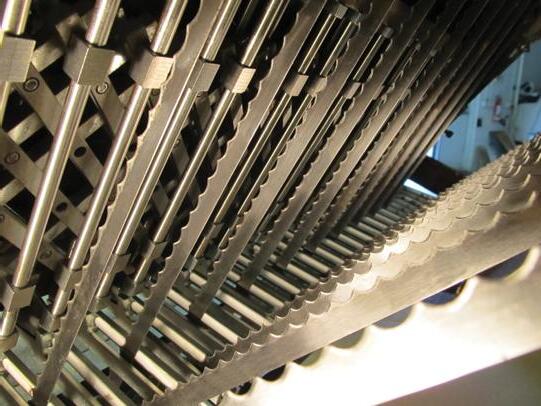
59 MARKETS
Bakery Gross profit 2020 Gross profit 2019 Bäckerei Konditorei Wolf GmbH, Augsburg 31,273,968 31,955,599 Bäckermeister Grobe GmbH & Co. KG, Dortmund 30,994,445 29,515,010 Backhaus Hennig GmbH, Zwenkau 40,259,217 38,533,316 Brinker Verwaltungsgesellschaft mbH, Herne (Group) 33,412,121 33,946,205 Landbäckerei Stinges & Söhne GmbH, Brüggen 36,466,230 38,429,089 Merzenich-Bäckereien GmbH, Köln 37,219,287 35,864,722 Privat Bäckerei Wimmer GmbH & Co. KG, München 30,530,699 30,627,788 Stadtbäckerei Hürth Klein' s Backstube GmbH, Hürth 38,865,271 36,458,432 Stendaler Landbäckerei GmbH, Stendal 37,359,455 16,323,779
Table 4: Large companies with gross profit between EUR 30 million and EUR 40 million
Bakery Gross profit 2020 Gross profit 2019 Anton Hosselmann GmbH & Co. KG, Hamm 24,265,203 25,109,501 Bäckerei Evertzberg GmbH & Co. KG, Remscheid 21,438,467 22,906,052 Bäckerei Happ GmbH & Co. KG, Neuhof 27,841,700 25,696,693 Bäckerei Herbert Meyer und Sohn GmbH, Wahrenholz 21,454,871 21,291,251 Bäckerei Keim GmbH, Reutlingen 23,245,418 13,450,923 Bäckerei M. und K. Horsthemke GmbH, Oberhausen 20,824,633 23,737,465 Bäckerei Maurer GmbH, Winnenden 21,604,916 21,517,312 Bäckerei Peter Schmitt GmbH, Bad Kissingen 20,874,398 20,623,365 Bäckerei Schwarz GmbH & Co. KG, Lindenberg/Allgäu 25,666,343 26,990,034 Bäckerei und Konditorei Hensel GmbH, Enger 20,845,740 20,839,879 Bäckerei und Konditorei Treiber GmbH, Steinenbronn 20,164,371 20,045,335 Bäckerei Wilhelm Geiping GmbH & Co. KG, Lüdinghausen 22,939,094 22,362,931 Bäckerhaus Veit GmbH, Bempflingen 20,419,422 22,542,341 Backhaus Hackner GmbH, Gaimersheim 22,572,846 22,999,941 Backhaus Lüning GmbH, Bingen 25,047,632 25,305,173 Barbarossa Bäckerei GmbH & Co. KG, Kaiserslautern 28,229,093 29,067,779 Providing high quality blades for 85+ years. Partner with our experience to optimize your slicing. Sharp. Strong. Quality Blades. + +1-563-386-1131 • sales@hansaloy.com • www.hansaloy.com
Table 5: Medium-sized companies with a gross profit between EUR 20 million and EUR 30 million
Table 5: Medium-sized companies with a gross profit between EUR 20 million and EUR 30 million
www.bakingbiscuit.com 04/2023 MARKETS 60
Bakery Gross profit 2020 Gross profit 2019 BB Rösner Backstube GmbH, Würzburg 22,406,440 23,184,863 Döbbe Bäckereien GmbH & Co. KG, Mülheim a. d. Ruhr 24,925,438 25,254,174 Essmann´s Backstube GmbH, Altenberge 25,779,974 25,114,456 Ferdinand Voigt GmbH Bäckerei und Konditorei, Swisttal 27,865,328 26,434,051 Gäubodenbäcker Hahn GmbH, Geiselhöring (Group) 27,791,878 30,490,995 Gilgen's Bäckerei & Konditorei GmbH & Co. KG, Hennef 23,217,439 21,923,430 Grimminger GmbH, Mannheim 23,036,180 24,670,817 Höflinger Müller GmbH, Neufahrn b. Freising 25,027,072 29,247,013 Karl Schmidt Beteiligungs GmbH, Preußisch Oldendorf (Group) 22,977,638 21,051,520 Karlchen's Backstube GmbH, Lohne 24,024,630 23,781,130 Landbäckerei Sommer GmbH, Eslohe 20,900,239 20,576,444 Peter's gute Backstube GmbH & Co. KG, Bühl 23,230,708 22,344,484 Sternenbäck GmbH Gera, Gera 23,599,375 24,002,108 Sternenbäck GmbH Spremberg, Spremberg 25,607,063 23,502,907 Sternenbäck GmbH, Hechingen 23,822,256 23,990,838 Trölsch GmbH, Korntal-Münchingen 26,421,027 28,843,660 Viehmeier GmbH & Co. KG, Gilserberg 27,913,064 30,049,798
Bakery Gross profit 2020 Gross profit 2019 Bäcker Müller GmbH & Co. KG, Burgwald-Ernsthausen 12,380,369 13,358,814 Bäckerei Bertermann GmbH, Minden 15,450,616 15,981,310 Bäckerei Ebbing GmbH & Co. KG, Coesfeld 12,799,867 13,131,112 Bäckerei Engel GmbH & Co. KG, Höxter 17,809,813 18,200,855 Bäckerei Gillen GmbH, St. Wendel 17,621,037 16,113,673 Bäckerei Hoenen GmbH, Kempen 13,761,950 12,421,101 Bäckerei Konditorei Niehaves GmbH & Co. KG, Wickede 18,994,796 19,984,944 Bäckerei Leifert GmbH, Gifhorn 12,445,105 12,704,362 Bäckerei Sipl GmbH, Denkendorf 13,819,601 12,556,358 Bäckerei Staib GmbH & Co. KG, Ulm 16,171,046 15,274,663 Bäckerei und Konditorei Schwerdtner GmbH, Löbau 16,803,329 17,051,380 Bäckerei Wilhelm Middelberg GmbH, Bad Iburg 14,128,771 17,444,082 Bäckereibetriebe Betz GmbH, Neu-Ulm 11,526,042 11,565,253 Bäckerei-Konditorei Busch GmbH, Monheim 15,087,531 15,351,252 Backhaus Mahl GmbH & Co. KG, Stetten a. k. M. 18,705,965 17,486,039 Backhaus Schmid - Kuhn GmbH, Schwäbisch Gmünd 11,769,650 12,716,862 Backhaus Schröer GmbH, Wiesbaden 15,302,966 15,410,014 Backhus Brot- und Backwaren GmbH & Co. KG, Güstrow 10,196,802 10,324,078 Feinbäckerei Ruch GmbH, Rosdorf 18,510,665 19,659,037 Feinbäckerei Thiele GmbH, Göttingen 15,026,282 15,705,750 Goeken backen GmbH, Bad Driburg 19,872,115 20,394,208 Handwerksbäckerei Mack GmbH & Co. KG, Westhausen 17,137,639 17,485,738 Helmut Ratschiller Spezialbrote GmbH, Holzkirchen 16,281,352 18,612,568 Karl Wellmann GmbH, Osnabrück 11,101,662 11,650,595 Lange GmbH & Co. KG Bäckerei Konditorei, Salzkotten 18,446,760 18,305,046 Lechtermann-Pollmeier Bäckereien GmbH & Co. KG, Bielefeld 16,942,074 17,355,647 Mecklenburger Backstuben GmbH, Waren (Müritz) 19,458,999 24,263,820 Meisterbäckerei Schneckenburger GmbH & Co. KG, Tuttlingen 16,029,485 16,144,313
Table 6: Small enterprises with a gross profit between EUR 10 million and EUR 20 million
Table 6: Small enterprises with a gross profit between EUR 10 million and EUR 20 million
Table 7: Microenterprises with gross profit below EUR 10 million
Central results of the study
The key figures shown in Figure 2 were used for the analysis. In addition to these key figures, the personnel density was also evaluated as a proportion of total personnel expenses in relation to gross profit. The results shown with the average were measured with the median, because so-called ‘outliers’ upwards and downwards are not included in the average.
Profitability has improved significantly in the sample compared to the previous year. This finding is in line with the general trend of increasing turnover according to industry statistics. The average return on assets increased by over 2 percentage points across the sample, from 9.95 to 12.11%. The cash flow return on gross profit also increased, from 8.84 to 9.47%. This trend is almost universally evident throughout all size categories. It can thus be concluded that, compared to the previous year, all the capital employed was used profitably and there is still gross profit left over for investments, debt repayments and distributions.
The strengthening in profitability is also accompanied by an improvement in financial stability. The cash flow ratio, and the liquidity generated to service short-term liabilities, respectively, rose by a full 12.38 percentage points, across all size categories. The equity ratio, which is of great importance from the point of view of moneylenders in assessing creditworthiness, also rose slightly from 21.43 to 22.27%. The dynamic debt/equity ratio, which expresses the debt repayment period in years, is at 0.0 in both periods also unproblematic.
The asset structure provides information on the efficiency with which fixed assets are used to generate cash flow, on

investments made and on the age of production equipment and facilities. It also provides information on how much net working capital is available for inventories and for managing the production process. The asset efficiency rate averaged 34% in both periods. It has risen for mediumsized companies; however, it has fallen slightly for very large and very small companies. The investment rate declined slightly overall, but increased for the two large groups M and S. The asset utilization rate was lower for the very large and very small companies. The asset wear and tear ratio is stable at 68.5% in both years – an acceptable value. The working capital ratio was consistently negative in 2019. The median was -24.17 %. The tide turned in 2020, when it became +10.04 %. For groups M and S, it was still negative at -0.61 (yoy -26.09%) and -19.01% (yoy -44.32%) respectively. This means that the capability of the enterprises to finance themselves has improved considerably.
Personnel density has decreased by around 2.5%, to 54.7%. Due to differences in the business models, the personnel density lowers as the company size grows, which is expected. Thus, the spread between group XL (with 51%) and group XS (with 59%) is 8 percentage points. As a result of an online survey by the association in mid-2020, the companies named short-time work, the reduction of working time accounts and holidays as measures to cope with the challenges of the pandemic. Far fewer resorted to compulsory redundancy. Nevertheless, the search for suitable, skilled
61 MARKETS www.bakingbiscuit.com 04/2023
Bakery Gross profit 2020 Gross profit 2019 Oberhohenrieder Landbrotbäckerei Ed. Wolf GmbH, Haßfurt/Oberhohenried 16,626,272 17,014,929 Stadtbäckerei Kamp GmbH, Hagen 15,568,592 16,430,678 Stadtbäckerei Kühl GmbH & Co. KG, Grimmen 12,955,560 12,804,885 Stangengrüner Mühlenbäckerei Aktiengesellschaft, Lengenfeld 18,266,783 17,186,092 Thoks GmbH, Waltershausen 11,653,273 10,436,160 Vinzenz Zöttl Bäckerei - Konditorei GmbH & Co. KG, München 11,014,728 11,597,943 Wiener Feinbäckerei Heberer GmbH Weimar, Weimar 15,644,162 19,437,201 Zieglers Backstube GmbH, Schopfloch 12,660,831 13,337,274
Bakery Gross profit 2020 Gross profit 2019 Bäckerei Sipl VS GmbH, Denkendorf 7,730,708 7,097,538 Friedrich Viehmeier Bäckerei GmbH & Co. KG, Gilserberg 8,292,434 8,653,255 Hermann Armbruster GmbH & Co. Backwaren KG, Schutterwald 8,098,001 10,893,874 Jung & Schmitt GmbH Nachf., Schöneck 9,925,873 11,448,019 Rudolf Neff GmbH, Karlsruhe 9,955,659 10,814,515
© Pop Nukoonrat – 123rf.com
personnel remains one of the industry’s biggest problems. Only recently, the author spotted a notice in a bakery branch offering a ‘welcome bonus’ of EUR 500 for a new part-time colleague!
The expectation of around 70% of respondents (as of mid-2020) in the abovementioned online survey that sales would be worse in 2020 than in 2019 has fortunately not come true, by and large. On the contrary, the figures from this study show that bakery companies have come through the pandemic quite well. This is, of course, speaking from a high vantage point: at the level of the individual companies, the results turn out quite differently. For further information, please refer to the detailed results of the study on the Internet. +++
About the author
Profitability
Return on investment Return on total capital: (EBIT+ interest on borrowed
capital*100 Dynamic leverage ratio:

debt/Cash flow*100

Asset efficiency ratio: Cash flow/tangible assets*100 Investment rate:
additions/acquisition costs at the beginning of the year*100
Equipment wear rate:
depreciation/historical acquisition cost*100 Working capital ratio: (current assets –current liabilities)/current assets*100
A tax consultant, Prof. Dr. James Bruton also teaches business and corporate ethics with a focus on sustainability and CSR at the International Institute for Management and Economic
Education at the European University of Flensburg. He is the author of the book “Corporate Social Responsibility und wirtschaftliches Handeln. Concepts, Measures, Communication”
baking+biscuit international is published six times a year.
Single copies may be purchased for EUR 15. Subscription rates are EUR 75 per annum. Students (with valid certification of student status): EUR 40. (All rates include postage and handling, but not VAT).
Cancellation of subscription must be presented three months prior to the end of the subscription period in writing to the publishing company. Address subscriptions to the above stated distribution department.
Claims will not be accepted for any copies not received or lost copies due to reasons being outside the responsibility of the publishing company. This magazine, including all articles and illustrations, is copyright protected. Any utilization beyond the tight limit set by the copyright act is subject to the publisher’s approval.
Online dispute resolution in accordance with Article 14 Para. 1 of the ODR-VO (European Online Dispute Resolution Regulation): The European Commission provides a platform for Online Dispute Resolution (OS), which you can find at http://ec.europa.eu/consumers/odr
Valid advertising price list: 2023
PUBLISHING HOUSE
Food2Multimedia GmbH
Schoolkoppel 27 21449 Radbruch, Germany +49 4178 244 9797 www.foodmultimedia.de
EDITOR EMERITUS
Hildegard M. Keil hildegard_keil@t-online.de

PUBLISHER
James Dirk Dixon dixon@foodmultimedia.de
EDITOR-IN-CHIEF
Catalina Mihu mihu@foodmultimedia.de
EDITOR
Helga Baumfalk baumfalk@foodmultimedia.de
COPY EDITOR
Annie Dixon annie.dixon@foodmultimedia.de
SUBSCRIPTIONS
Viktoria Usanova usanova@foodmultimedia.de
DISTRIBUTION vertrieb@foodmultimedia.de
ADVERTISING
Dirk Dixon dixon@foodmultimedia.de
SOCIAL MEDIA
Annie Dixon annie.dixon@foodmultimedia.de
LAYOUT/GRAPHIC DESIGN
LANDMAGD Design aus der Heide
Linda Langhagen, design@landmagd.de
PRINT
Leinebergland Druck GmbH & Co. KG Industriestr. 2a, 31061 Alfeld (Leine), Germany

IT
IT Consulting BRUNK Felix Brunk, felix@brunk-net.de
MARKETS 62
IMPRINT www.bakingbiscuit.com 04/2023 ADVERTISER DIRECTORY American Pan 13 AMF Bakery Systems 41 Ashworth 43 backaldrin 37 Coatresa 25 Forbo Siegling 5 FRITSCH 21 Hansaloy 59 Intralox 49 IPCO 31 J4 51 Kempf 9 Koenig, Werl 47 Kwik Lok 11 Mecatherm 19 Middleby 35 Rademaker 45 Royal Kaak 64 Verhoeven Bakery Equipment Family 2 VMI 53 Werner & Pfleiderer 33
Cash
Cash
Equity
Equity/total
capital)/Ø total capital*100 Cash flow gross profit yield:
flow/Gross profit*100 Cash flow ratio:
flow/short-term liabilities*100
ratio:
Net
Asset
Accumulated
Profit Liquidity Financing Fixed assets Working capital Financial Stability Asset structure
Figure 2: The system of key figures used

KEEP UP TO DATE STAY RELEVANT Your connection to insights into: + Bakery technology + Market trends + Science and Research www.bakingbiscuit.com Subscribe: usanova@foodmultimedia.de





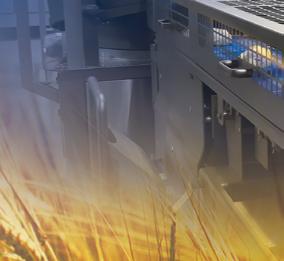

Best Lead Time 24/7 Support Hygienic Design Line Integration Sustainable Development Goals From silo to truck Solutions for your bakery kaak.com Whether you need a single machine or turn-key line































 David
Director,
David
Director,








 Ben Baker
Ben Baker










































































































